We were first drawn to visit Morocco by the photos. How could we not be? The bright blue doors of Chefchaouen, the ochre waves of desert sand, the multi-colored medinas—there are so many spectacular things to see in Morocco. We discovered that it was all of that and much more. Morocco travel is indeed alluring and thought-provoking, but it’s not without its challenges.
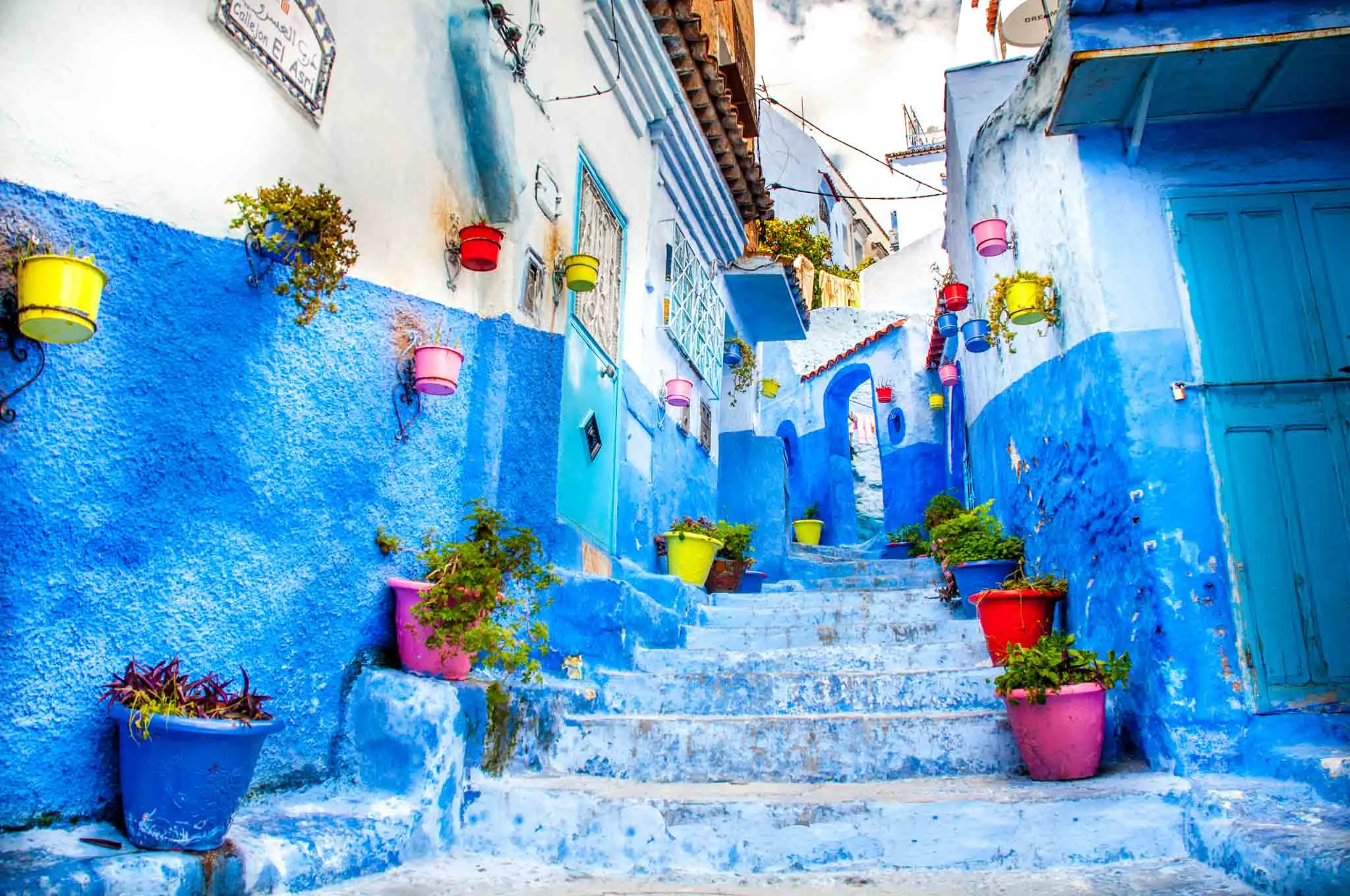
If much of your travel experience has been in the US or Europe, some things about North Africa may come as a surprise. From the multiple languages spoken to the traditions of a Muslim-dominant country, traveling to Morocco is different from traveling to England or Italy. And with every travel experience, setting expectations and being informed are important parts of having a great time.
Tips to Know Before Traveling to Morocco
These are just a few of the Morocco travel tips we learned from our trip.
Morocco is huge
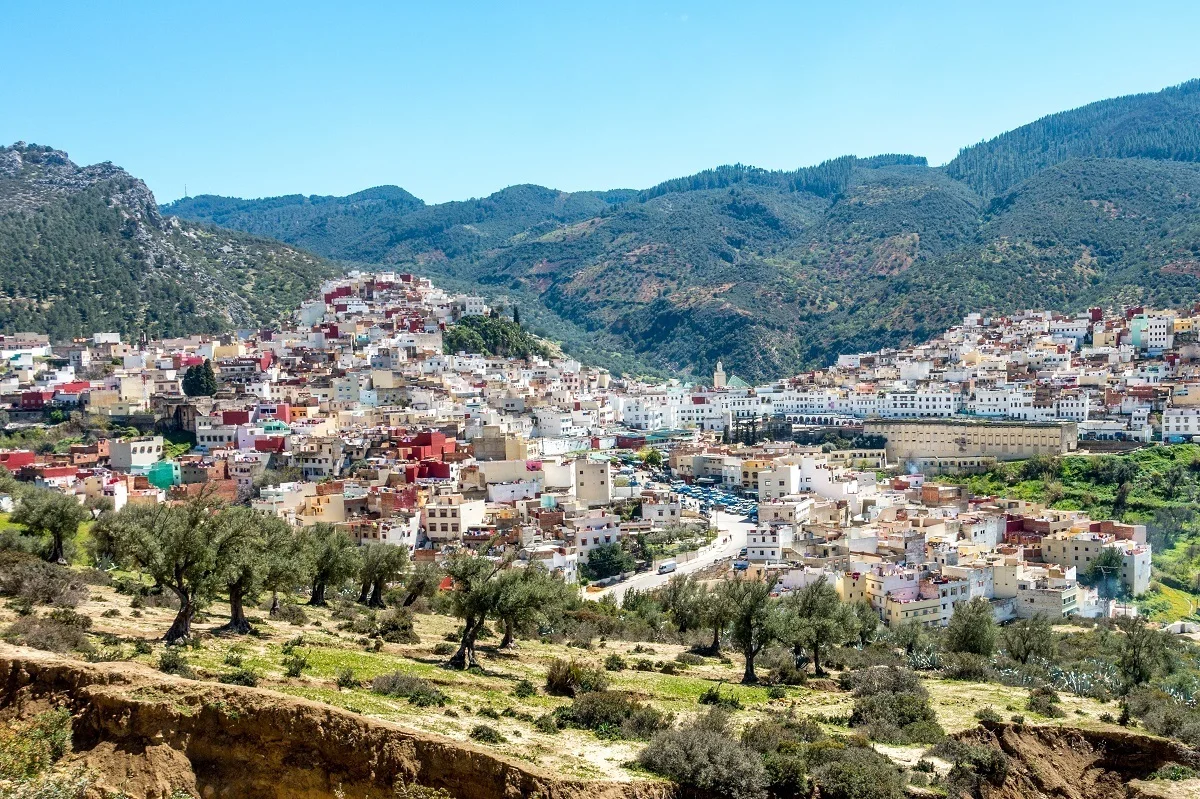
Morocco is enormous. Wrapping around the northwestern coastline of Africa, it touches the Mediterranean Sea and the Atlantic and includes a huge swath of the Western Sahara Desert. Long and thin like many of the Scandinavian countries, Morocco is actually bigger than Norway. Only nine miles of ocean separate Morocco from Spain, which is how we visited Morocco the first time on a day trip to Tangier.
All this means that Morocco has soaring desert sand dunes, oases, a long coastline with magnificent beaches, thriving cities, and more.
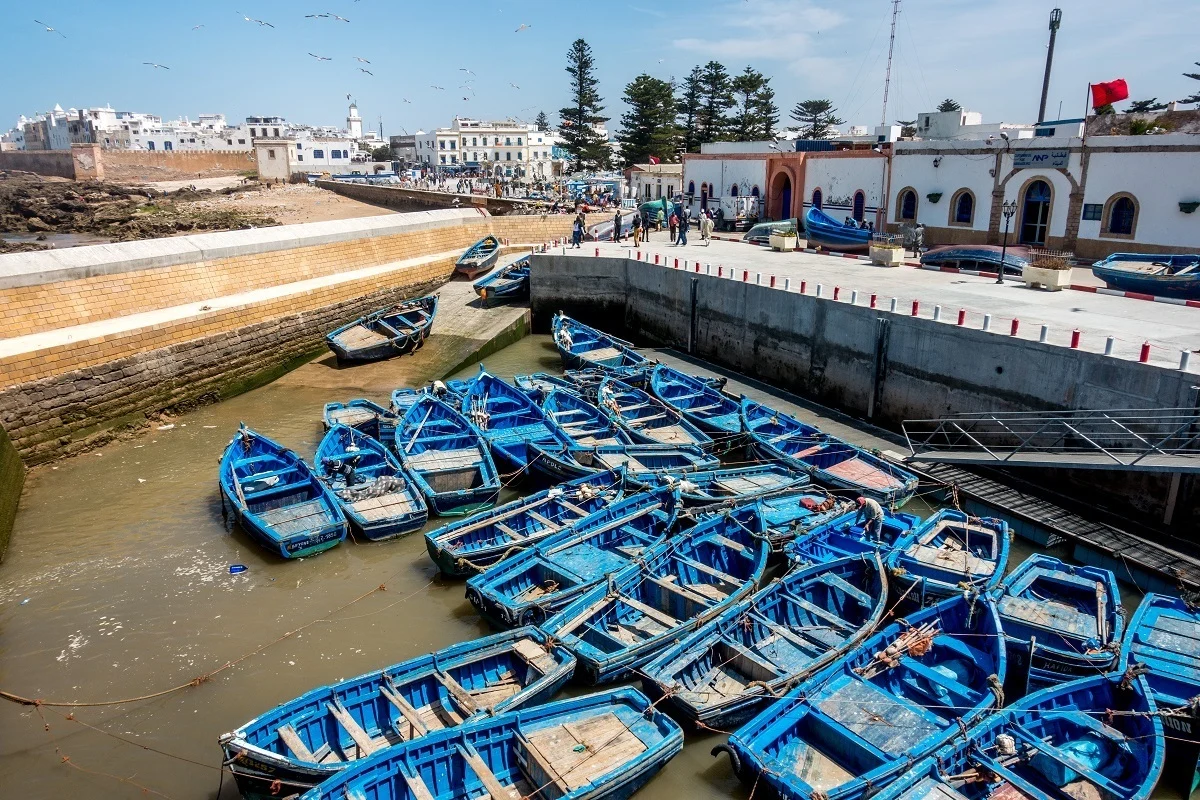
Many things in Morocco are definitely not close together, especially with the Altas Mountains running through the heart of the country. Don’t expect to be doing a day trip from Marrakech to Chefchaouen. Of course, your itinerary will dictate the distances you cover, and Morocco may not feel large at all. We had short trips like Casablanca to Rabat and really long trips like our seven-hour drive from Fez to Merzouga. Luckily, there’s lots to see everywhere in Morocco.
See how much ground we covered in our detailed two-week Morocco itinerary
Mosques are off-limits unless you’re Muslim
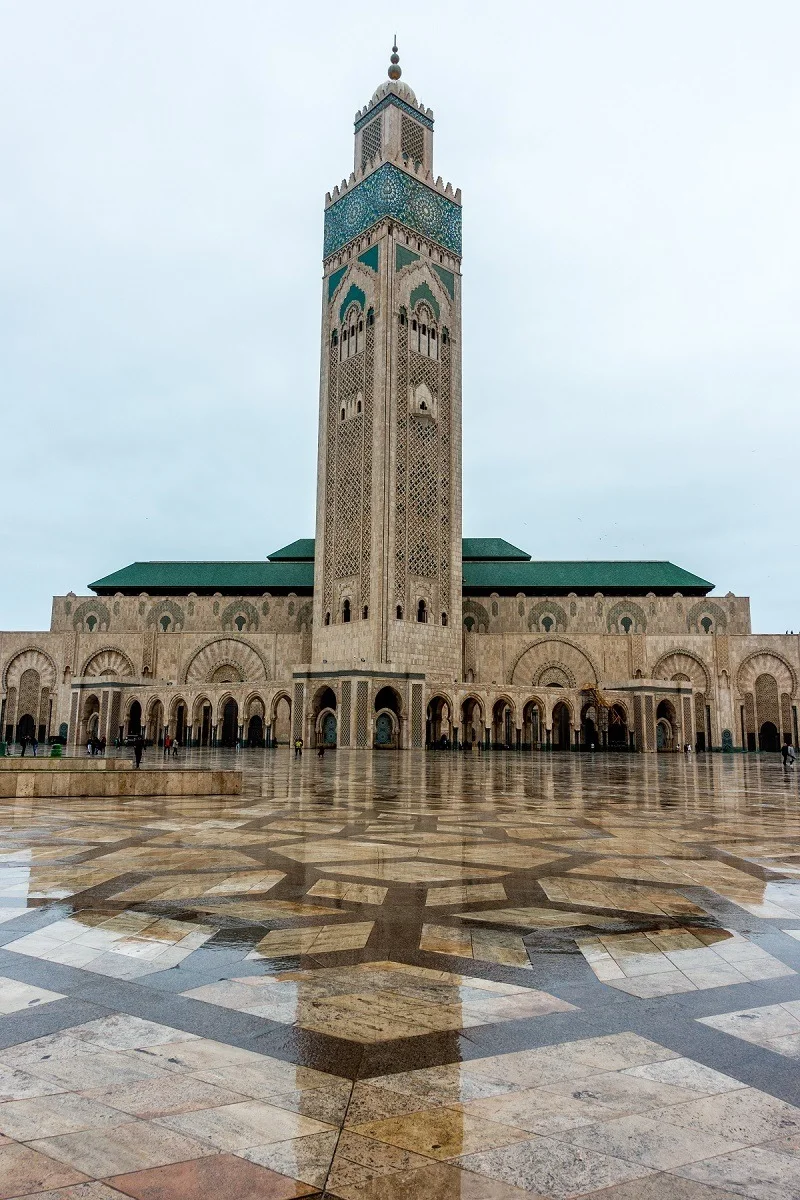
Mosques around the world are often highly decorated with gorgeous scrollwork, mosaics, and beautiful carpets. From Albania to Turkey and beyond, we have been to a handful of Muslim-dominant countries and always marveled at the mosques we visited. Often, they required special coverings and removing your shoes was always mandatory, but we were allowed in, even as non-Muslims. That’s not the case in Morocco, with one exception.
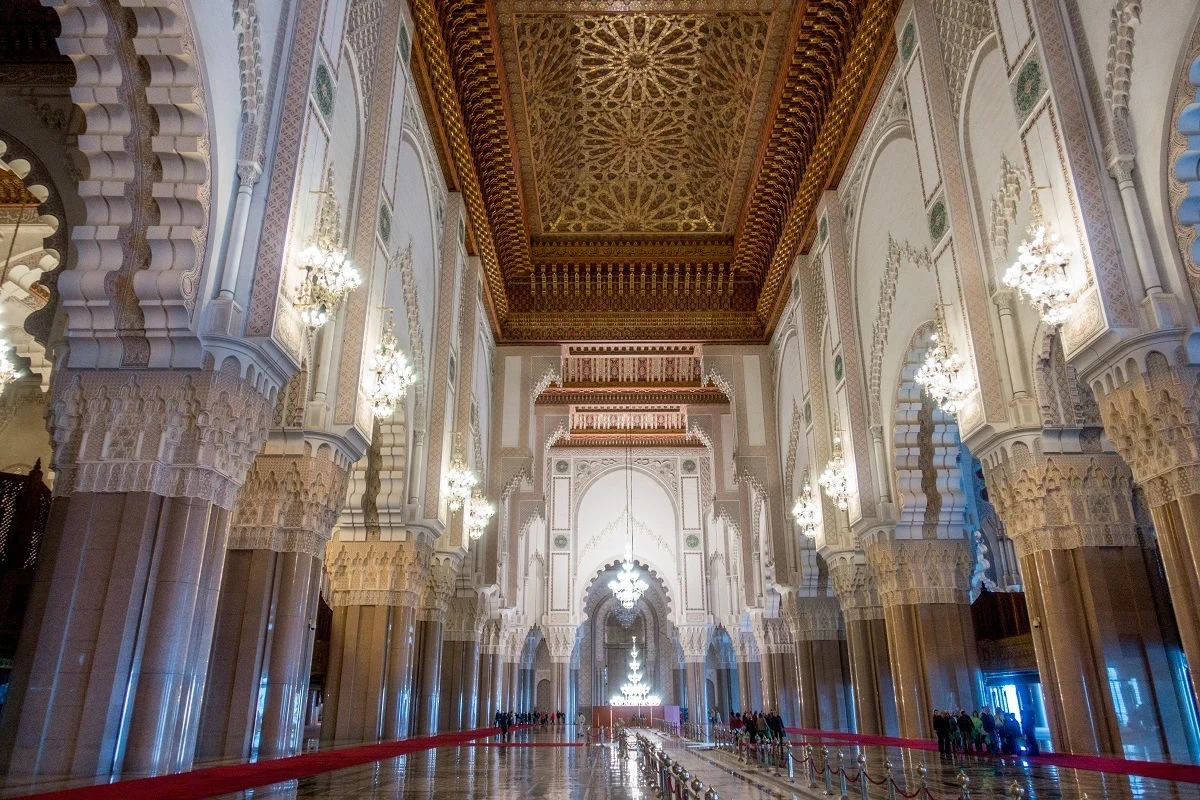
The only mosque tourists can visit on a trip to Morocco is Hassan II Mosque in Casablanca, the 5th largest mosque in the world. Built in 1993 on land that used to be part of the ocean, the mosque is grand and open to non-Muslims for guided tours every day. While Hassan II is huge, its decorations are minimal compared to other famous mosques. If you’ve never visited a mosque before or find yourself with free time in Casablanca, it is worth a visit.
No vaccines or visas are required to travel to Morocco
For Americans, the requirements for traveling to Morocco are easy. No visas are needed, and no vaccines are specifically required. The CDC does recommend Hepatitis A and Typhoid shots, but they’re not a must. We’re a little fanatical about getting what’s best for us, and luckily we were covered from a previous trip to Africa.
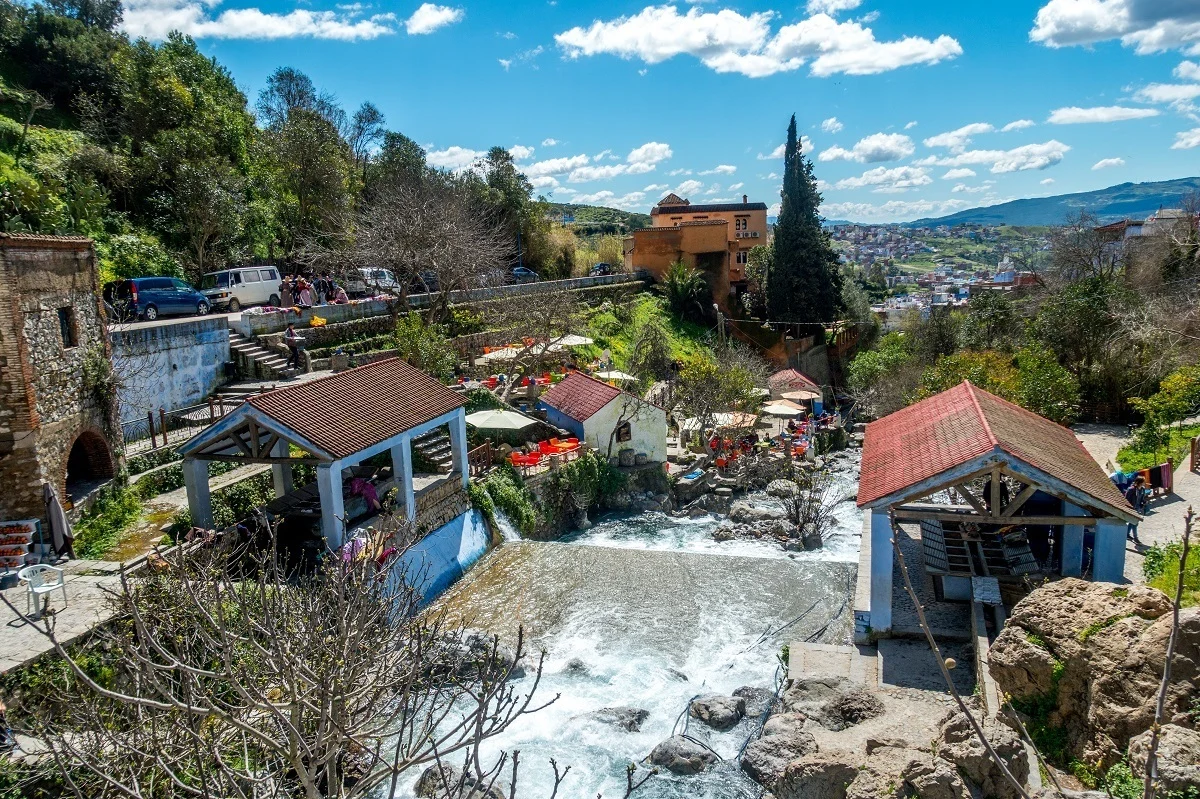
Morocco is gorgeous
The landscape of Morocco has so many different natural features. There are miles of beaches and mountains that rise up over 13,000 feet high. There are dramatic desert sand dunes and palm tree-filled oases. The variety is astounding.
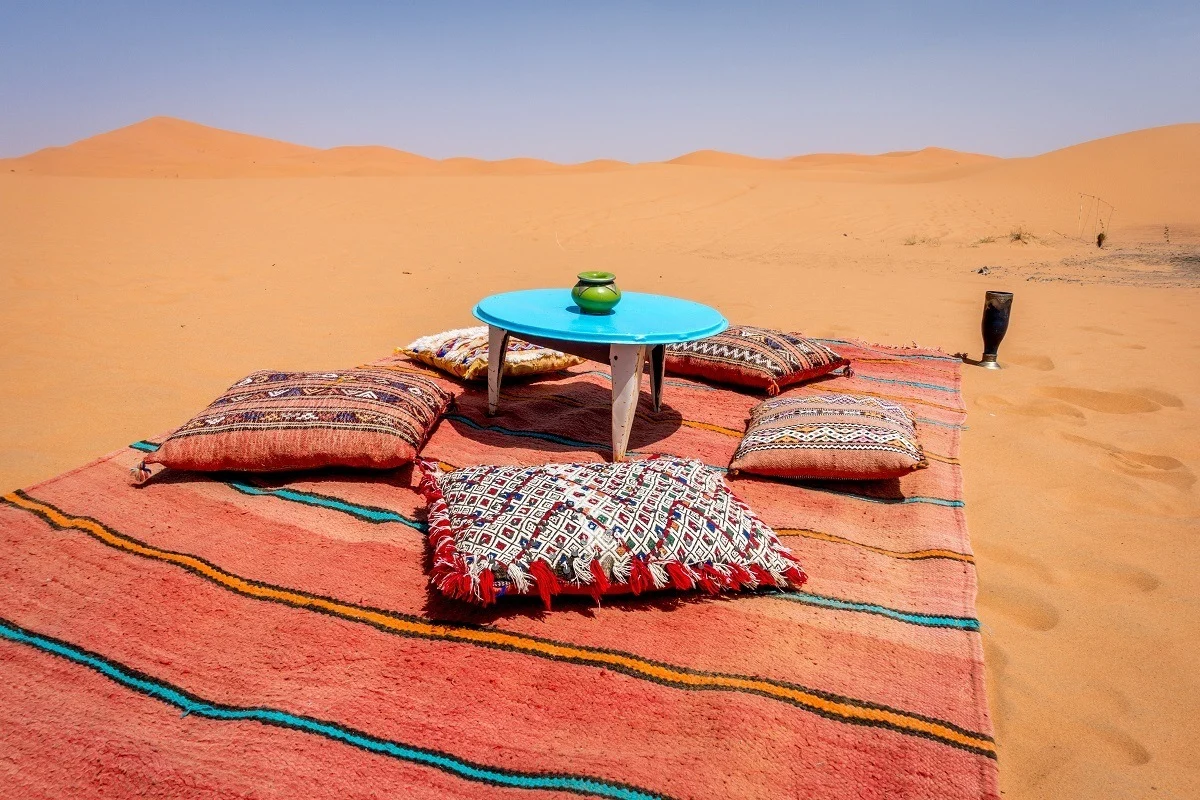
The cities of Morocco are a cacophony of colors, smells, and sounds. Artisans crafts shoes in the colors of the rainbow, food stands cook up the local specialty, and hawkers hawk…well, just about anything.
It all blends together to make Morocco one stunning place.
Morocco makes wine
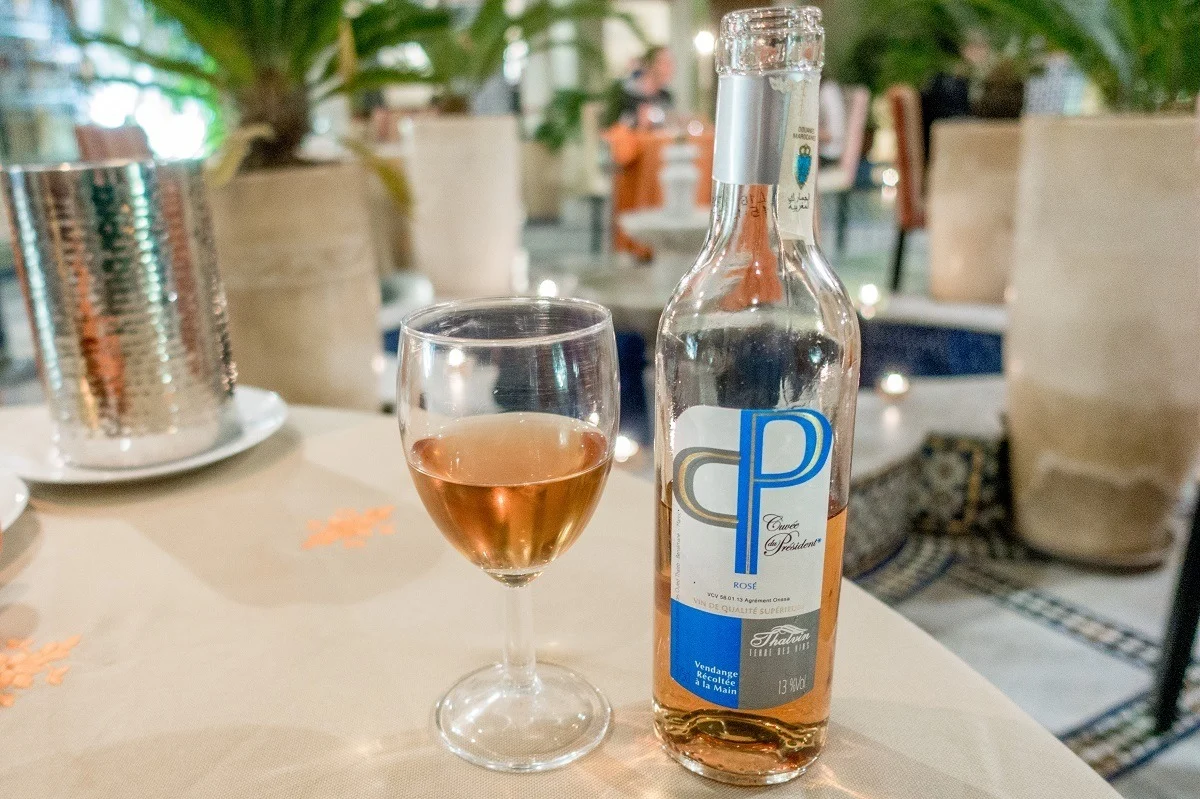
As a Muslim-dominated country, alcohol is somewhat scarce throughout Morocco. It is found in riads and some restaurants, but you generally won’t find alcohol in stores unless you’re going to the French supermarket Carrefour. Outside of larger cities, you can pretty much forget it.
That’s why we were stunned to learn that Morocco actually makes wine. If you think about the geography—not terribly far from the European wine powerhouses of Greece, Spain, and Italy—it makes a lot of sense. Culturally, however, it is unexpected.
There are a couple of wineries in Morocco producing red, white, and rose wines, and they’re very good. We enjoyed the Cuvee du President brand and the Sauvignon from Les Celliers de Meknès in restaurants and in one small wine store seemingly in the middle of nowhere (there are big benefits to having a Moroccan guide). Wine in Morocco—who knew?!
Bread is king
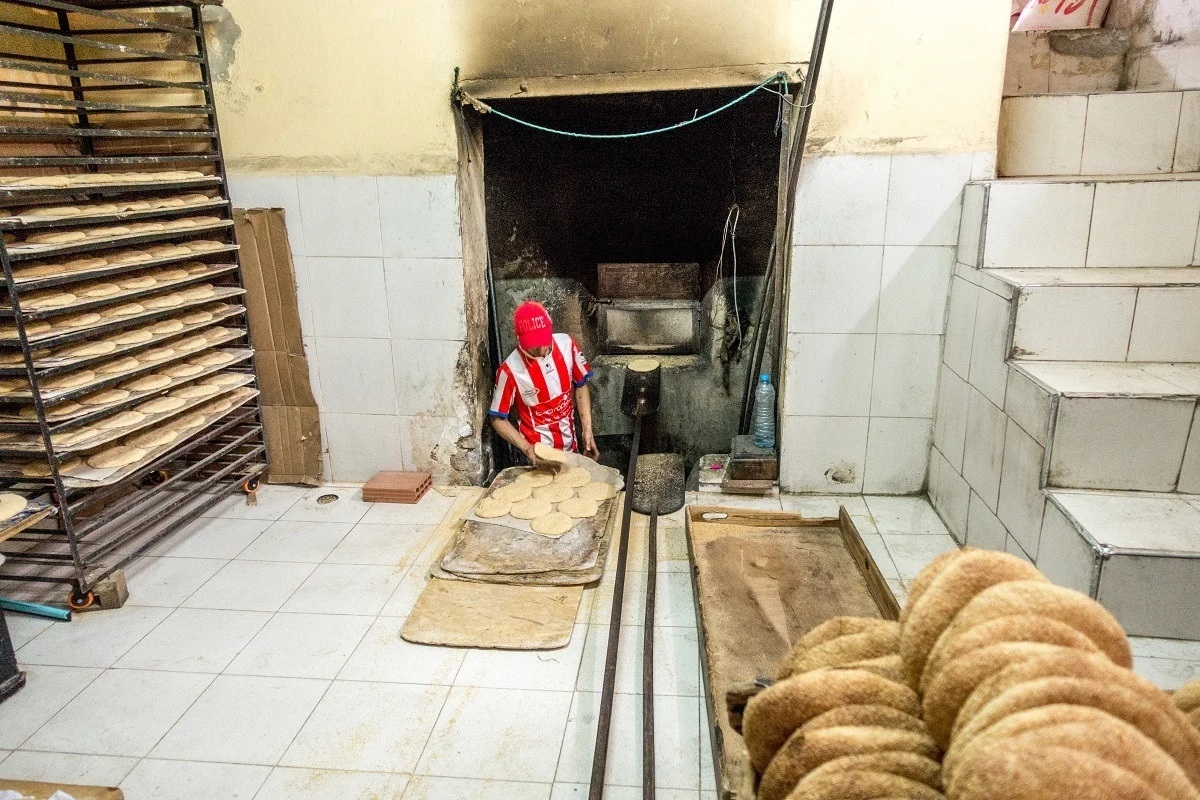
Bread is a staple in Morocco. It’s at every meal, covered in argan paste, used to mop up sauce from tanjia, or even used as a replacement for cutlery.
In Morocco, families often bring their dough to neighborhood bakeries to be baked during the day and picked up before dinner time. There’s a constant stream of loaves going in and coming out of the large ovens.
You’ll also see vendors rolling their carts full of hot loaves through the streets. Don’t be afraid to stop one of them for an inexpensive snack.
Fridays are holy days
Muslims observe holy days on Fridays, which means that almost everyone goes to the mosques to pray. As a result, business hours may vary from other days of the week, especially in the afternoons. Souks will certainly be quieter and many businesses will be closed.
In the evenings, however, things can get quite busy—especially in places like Jemaa el-Fna square in Marrakech—after prayers are over.
Many main tourist attractions remain open on Friday, but it is worth planning ahead if you have a must-see sight or experience on your Morocco itinerary.
You won’t be alone in the desert
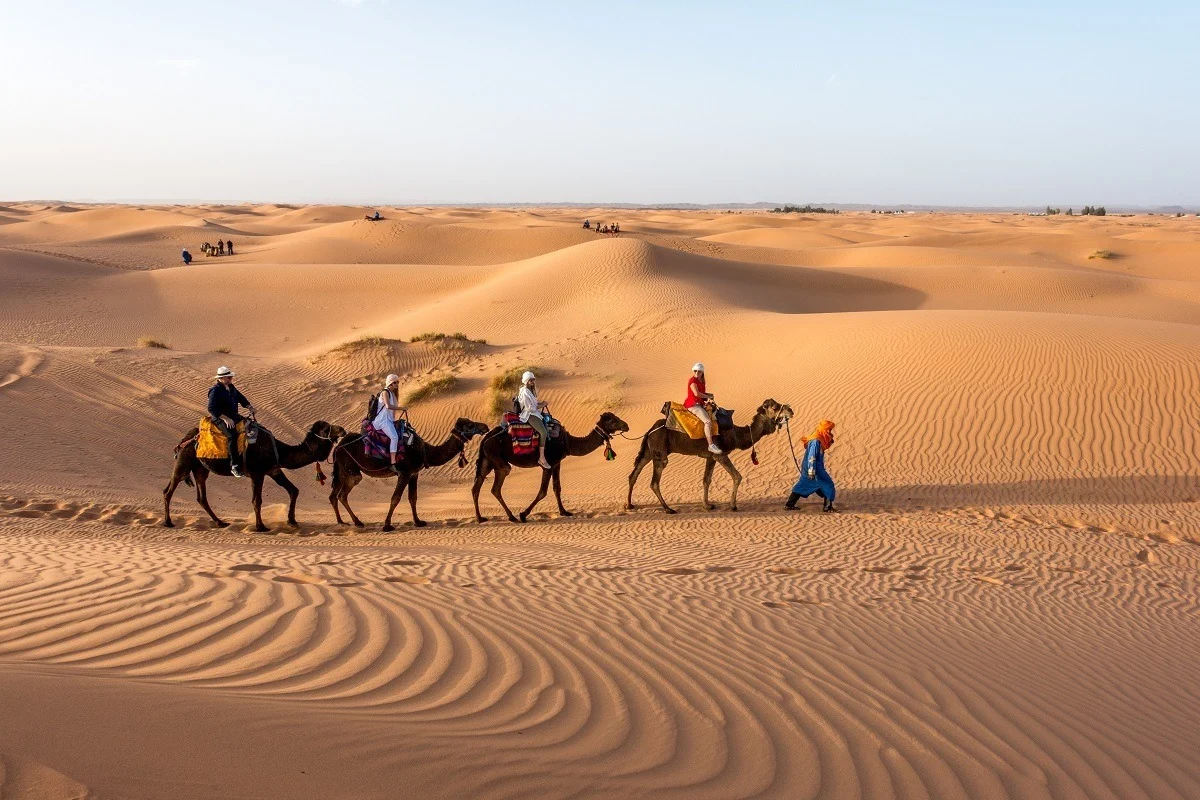
Before traveling to Morocco, I read lots of flowery accounts of people saying that visiting the desert in Merzouga was one of the best things they’d ever done—a once-in-a-lifetime highlight. My expectations were set very high for a magical experience.
What happened was a little more down-to-earth. Don’t get me wrong—we had a great time. The sand dunes were spectacular, and our desert camp was luxurious and exactly what we’d hope for.
But what we didn’t properly anticipate was that our camel ride out to our desert camp would come with dozens–if not hundreds–of other people. As we plodded our way out into the desert (just a couple of miles), there were numerous other caravans alongside us. As we waited at the top of the dunes for sunset, other visitors popped up in our photos and laughed and played music nearby. I was annoyed.
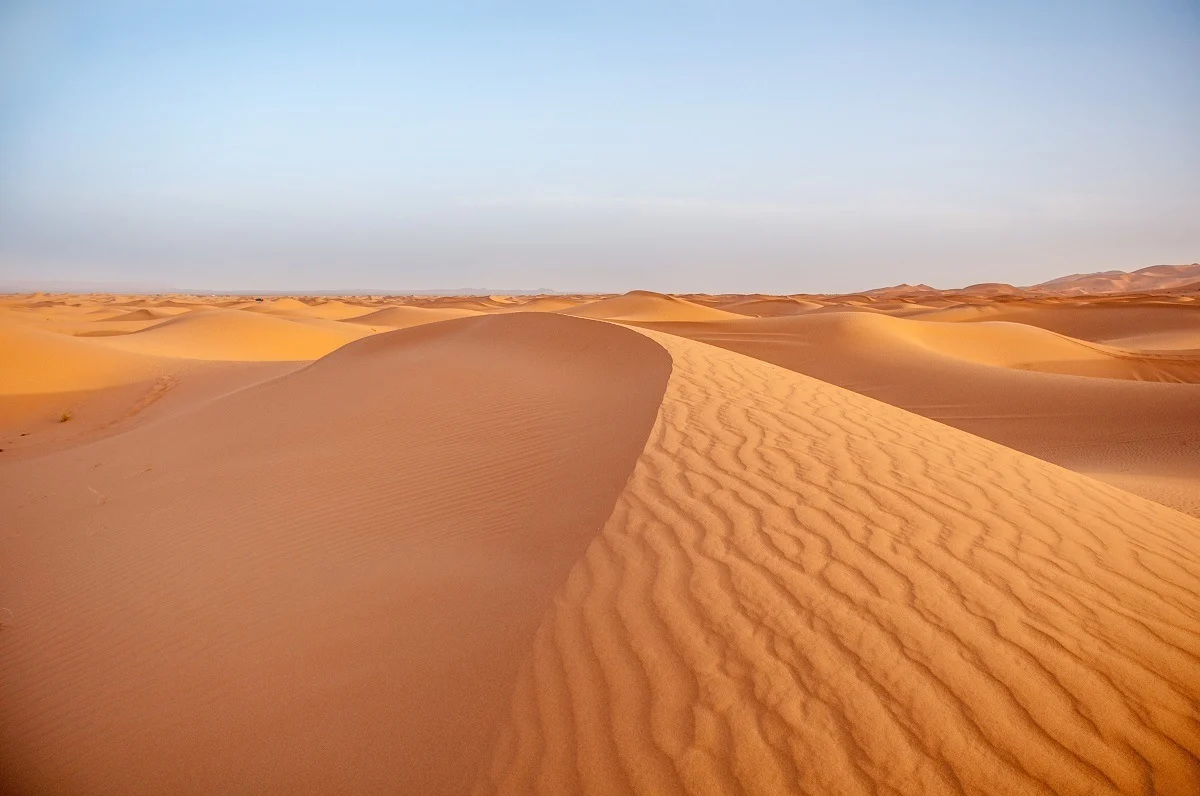
While getting to camp wasn’t the serene experience we’d anticipated, being in camp was amazing. And getting up for sunrise—which is totally NOT the norm for us—couldn’t have been better. Watching the sun cast its first rays on the ruddy dunes as we walked silently through the sand was marvelous.
We had a wonderful experience but wished we had set our expectations appropriately.
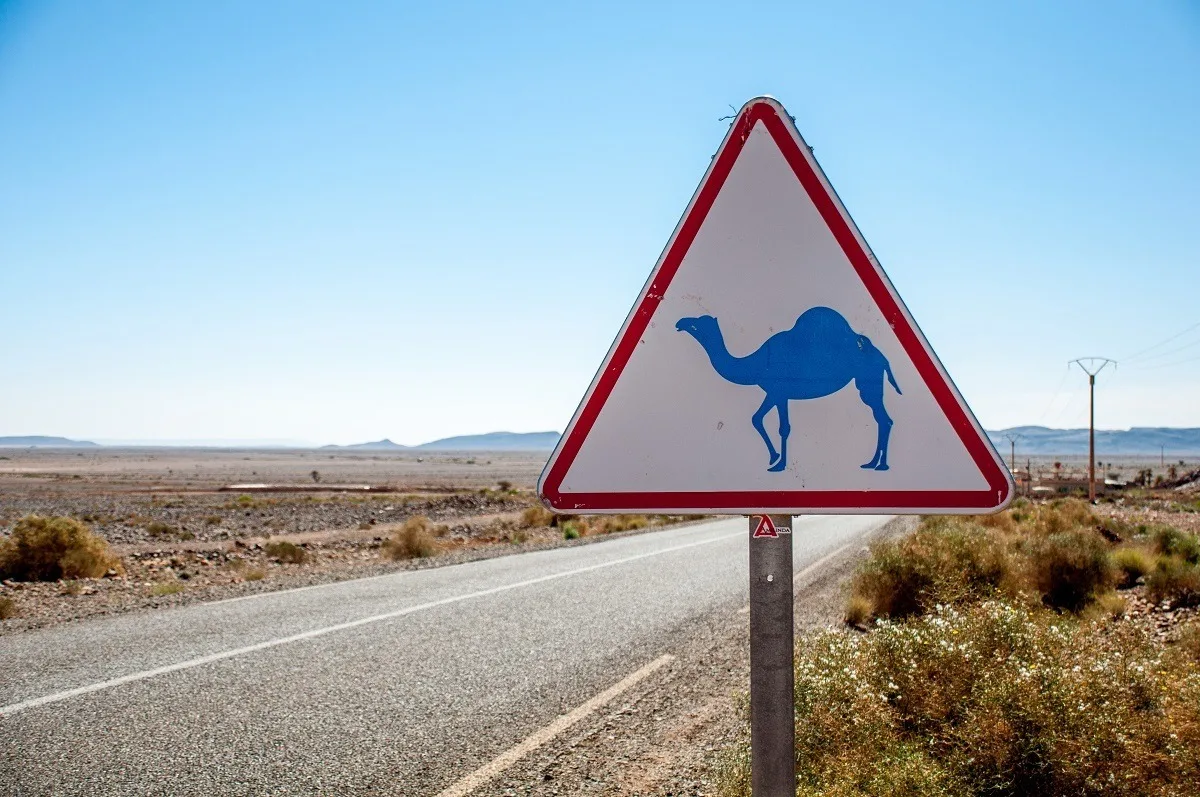
Moroccans’ language skills are extraordinary
There are two official languages in Morocco—Arabic and Berber. They’re both spoken widely, though you will probably hear more Arabic in the cities. Although French is not an official language, it seems to be everywhere, in spoken and written communication. You’ll find many people speak at least two of the three languages.
Some Moroccans even switch easily between Berber, Arabic, French, Spanish, and English. It’s mind-blowing.
Since most western tourists aren’t likely to have a good command of Berber or Arabic, knowing just a little bit of French can take you very far. English is spoken in many of the more touristy spots, but a knowledge of even a few phrases of French could be helpful.
On our trip, we encountered many restaurants that did not have English menus, and the proprietors of our riad in Marrakech didn’t speak English. The little bit of college French I remember a decade later—supplemented with some help from Google translate—was essential when ordering at restaurants and asking for simple things like a hair dryer at our riad. Our travel advice for Morocco? A basic phrase book and memorizing a handful of basic words are good ideas.
Expect to see storks
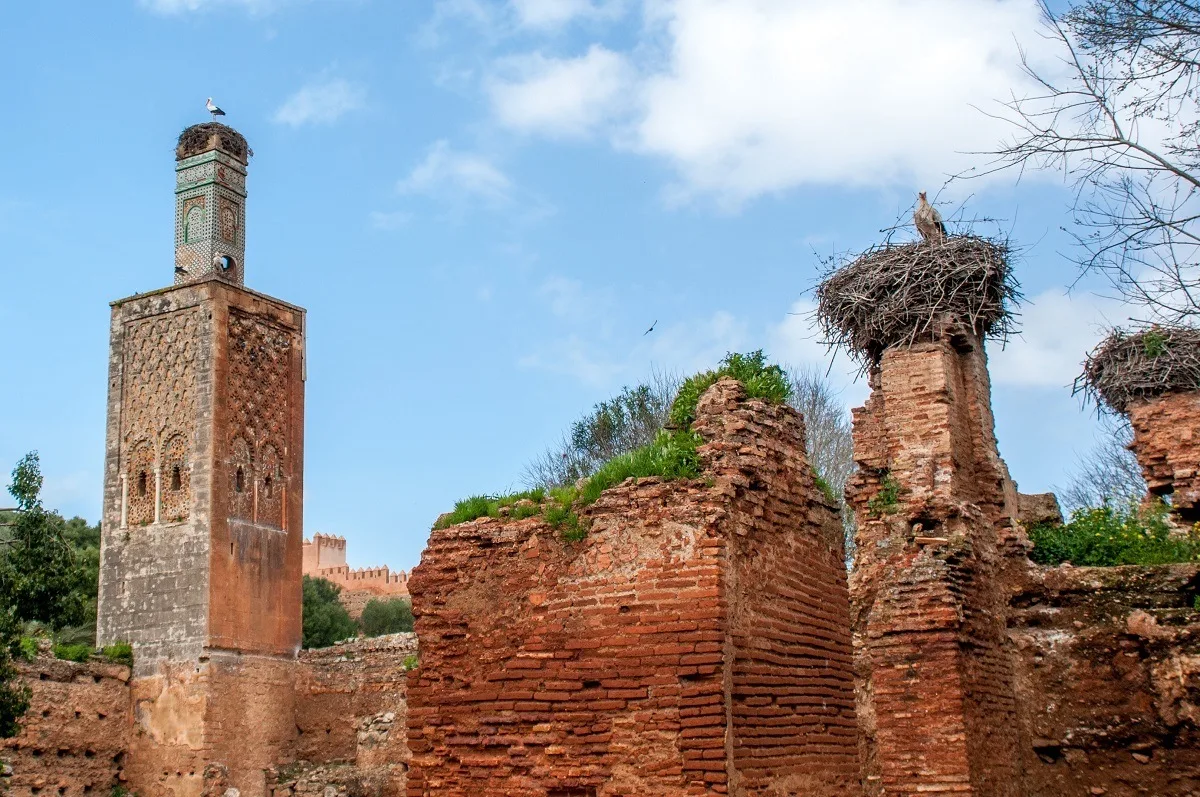
Stray cats, donkeys, and even monkeys are expected in different places in Morocco. But one animal that completely surprised us were the storks.
Considered holy animals in Morocco, storks are often found nesting in the tops of minarets and other buildings. We saw them first in the ancient site of Chellah in Rabat, but they’re fairly common in Marrakech, too.
If you see one of the huge birds building a nest or hanging around, steer clear—disturbing a stork comes with a three-month jail sentence in Morocco.
Taking photos can be a no go
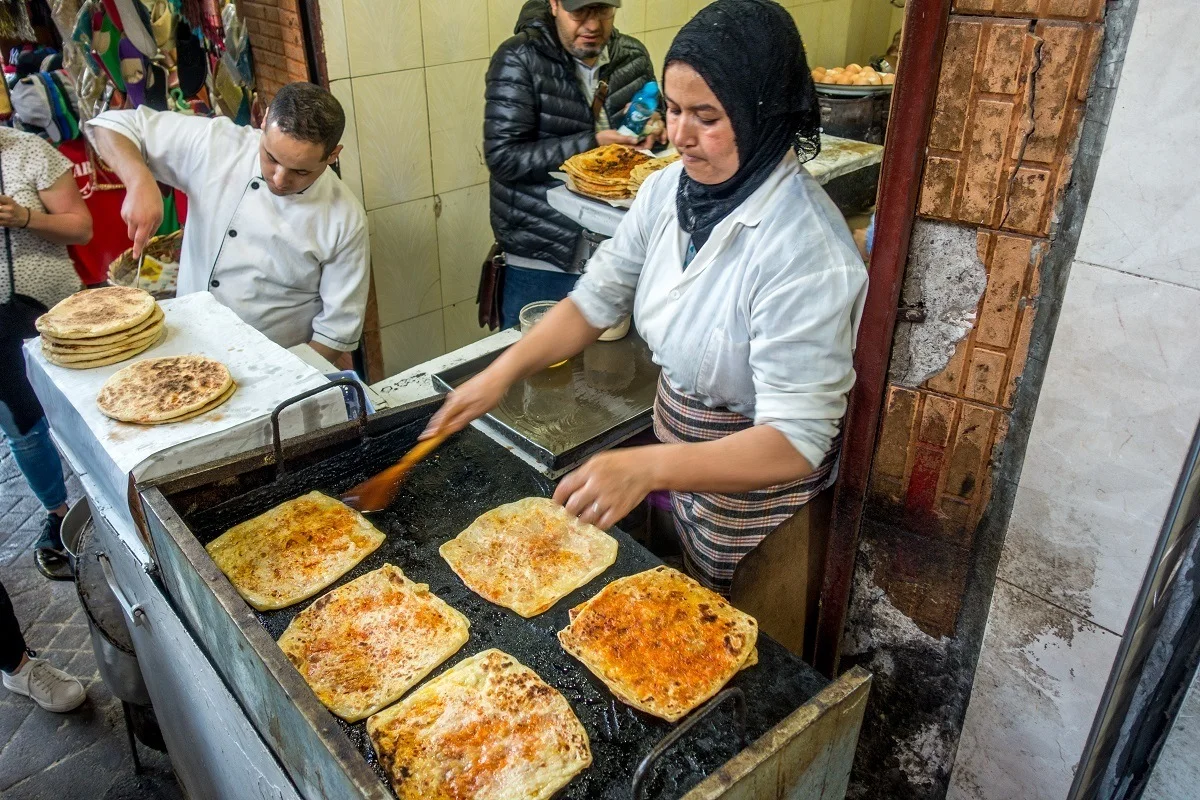
Be careful about what photos you take when visiting Morocco. Some people—especially women—will not want their photo taken at all and will shield their faces. Others will expect some baksheesh (a tip).
The same can be said at shops. Don’t expect that everyone will be OK with you taking photos of their stands or shops, even in the souks. It’s always a good idea to ask before taking pictures of a person or their merchandise. And if they want some coins, establish the price before you take the photo.
It’s also worth noting that photographing many of the royal palaces, guards, and police is off-limits. It can be very tempting for photographers because of the colors of the flags flown and the variety of uniforms, but make sure you know what’s legal. When in doubt, address one of the guards, point to your camera, and wait for an affirmative response. Being cautious is always better than getting in trouble.
Each city has a specialty
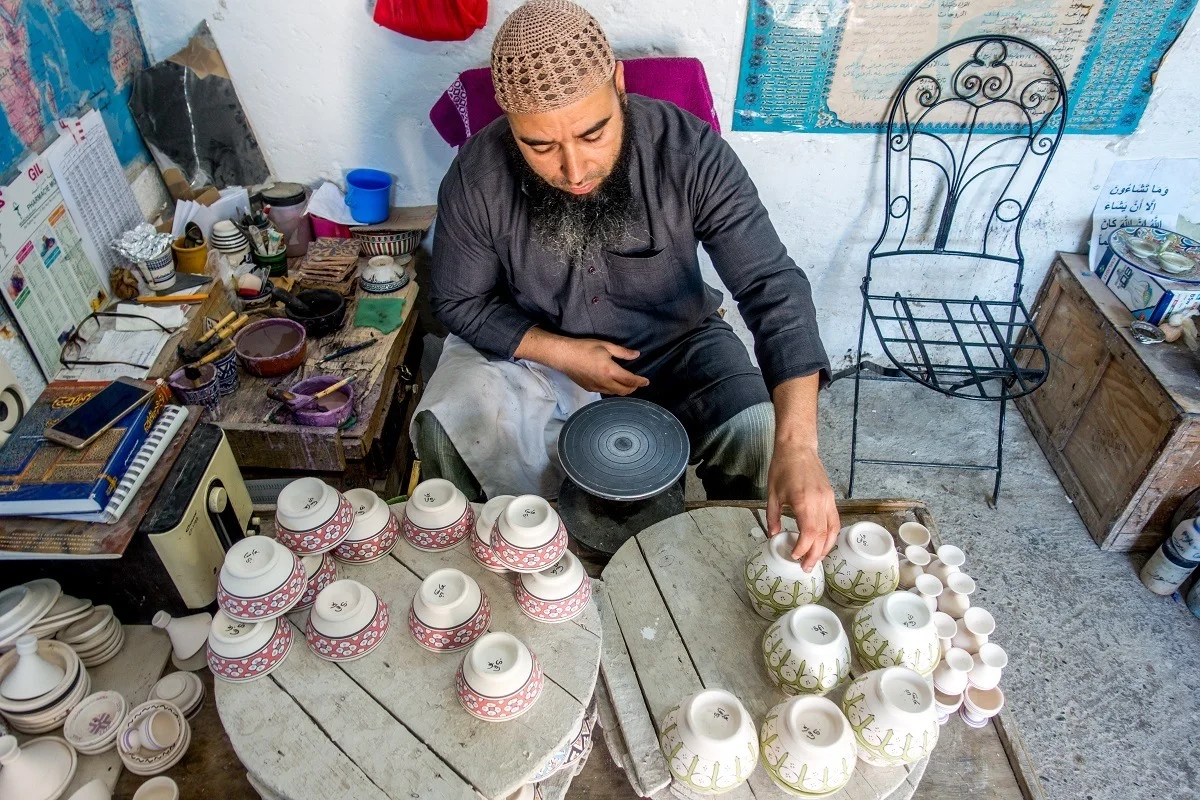
Many people visit Morocco with the intention of shopping because of the unique hand-crafted products. While it’s true that most things are available in most places, each city has something it’s particularly known for.
For instance, you only have to look at the famous tanneries of Fez and Marrakech to imagine that they have high-quality leather goods. Find a shop that only sells leather or that is an actual leather workshop for the best items (and usually the best prices).
When it comes to pottery, the city of Safi on the Atlantic coast is the top place to shop. If Safi is not on your itinerary, Fez is a great option. We visited a factory there where we watched the ceramics and mosaics coming to life in front of us—truly impressive!
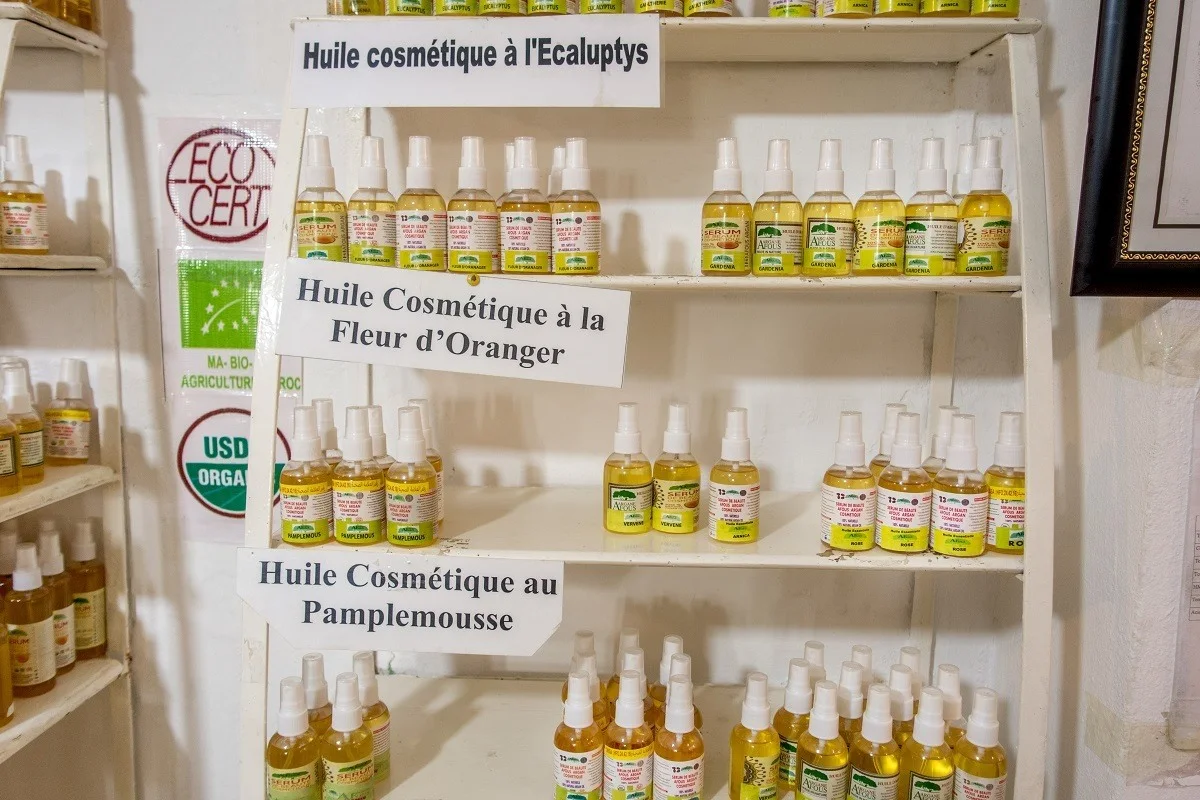
If you’re after argan products, be selective in your purchasing. This golden oil can be replaced by olive oil or other less expensive oils that don’t hold the same benefits as argan. Head to a pharmacy in one of the big cities. Better yet, stop at the women’s collective just outside of Essouira where you can watch the product being made to know what you’re getting is authentic. We came home with some delicious argan paste (tastes like out-of-this-world peanut butter) and cosmetic argan oil.
Whatever you’re in the market for, do a little research ahead of time so you can be prepared to get the best souvenir to remember your trip.
Immodium may come in handy
Most tap water in Morocco is generally safe to drink, especially in Marrakech. Food standards at restaurants and street food stands are also high, although we were warned against the carnival of food that is Jemaa el-Fnaa (Marrakech’s main square) at night because meat can sit out for a long time in warm temperatures.
Still, we usually stick to bottled water out of an abundance of caution. And, after a few incidents in Peru and Egypt, we’re always prepared with Immodium just in case. Vacation is a bad time to find out you’re more sensitive to certain foods (and microbes) than you thought.
Not everywhere has mint tea
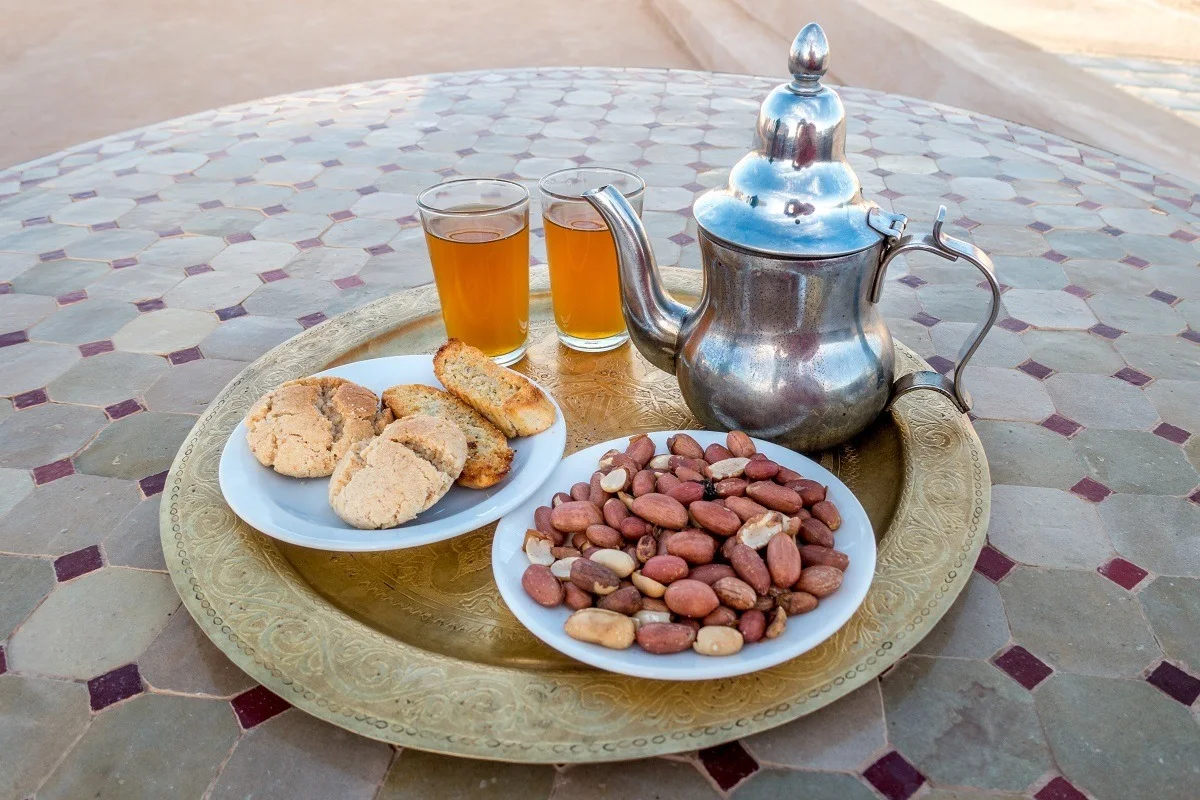
Mint tea isn’t just a drink in Morocco. It’s a welcome, a ritual, and a sign of hospitality. In a country where alcohol isn’t widely consumed, the bright—and usually very sweet—beverage is as prevalent as wine in France or beer in the US.
But typical mint tea isn’t the only kind you’ll find in Morocco. When we were served plain green tea in our guest house near the desert, we learned that mint tea is less common in some areas, especially among Berbers. You may find plain tea (sweetened or unsweetened) or Berber tea, which often has a mix of herbs like thyme, geranium, sage, lemon verbena, or wormwood that vary depending on the time of year.
Chefchaouen really is that blue
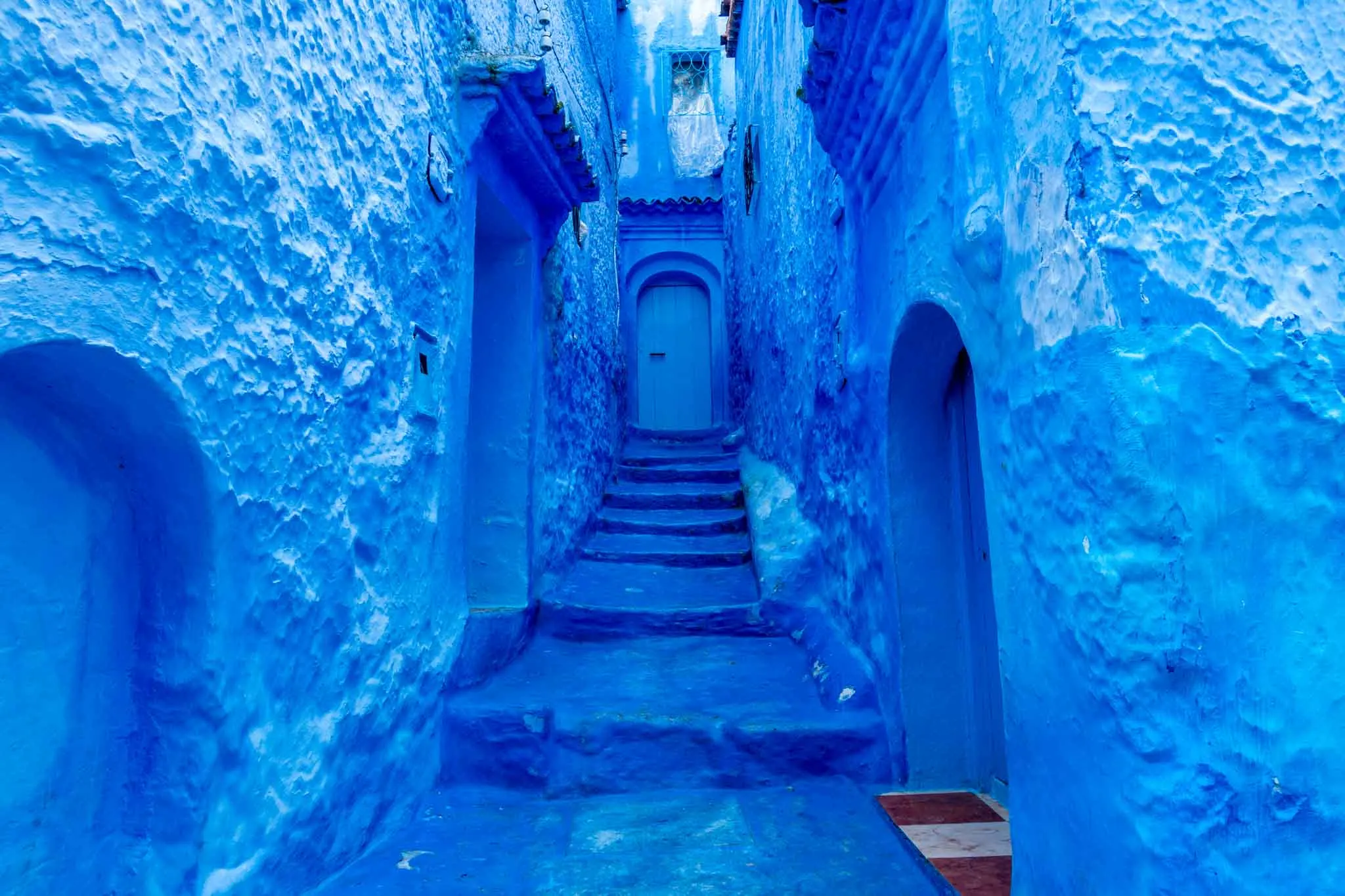
Photos of brilliant blue Chefchaouen were one of the reasons we became interested in visiting Morocco. When we finally planned our trip to Morocco, I didn’t care one bit that Chefchaouen wasn’t the easiest place to get to, I was determined that it would be on our itinerary. I also thought that maybe there was a chance it wasn’t really that blue all the time. It is.
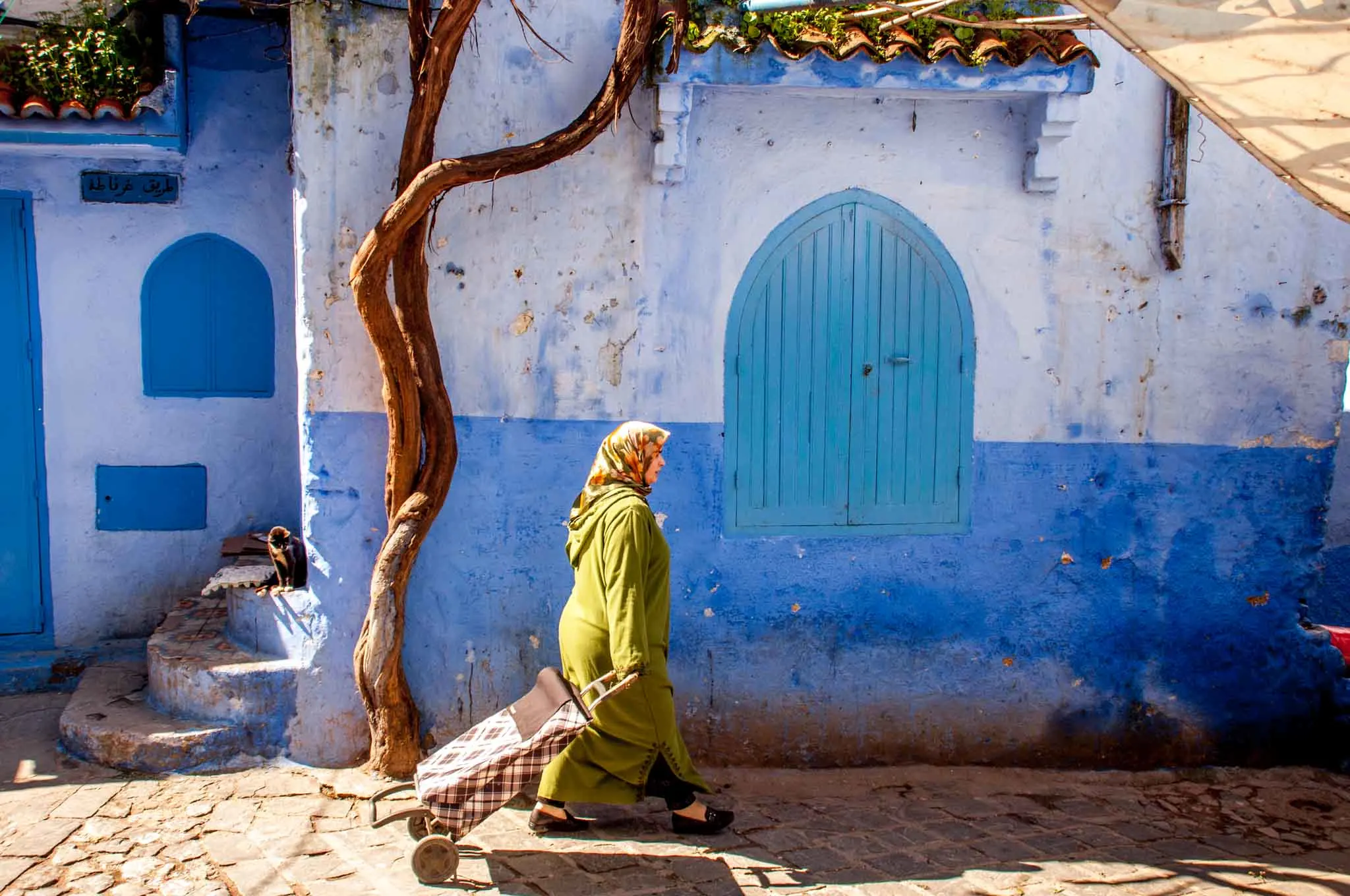
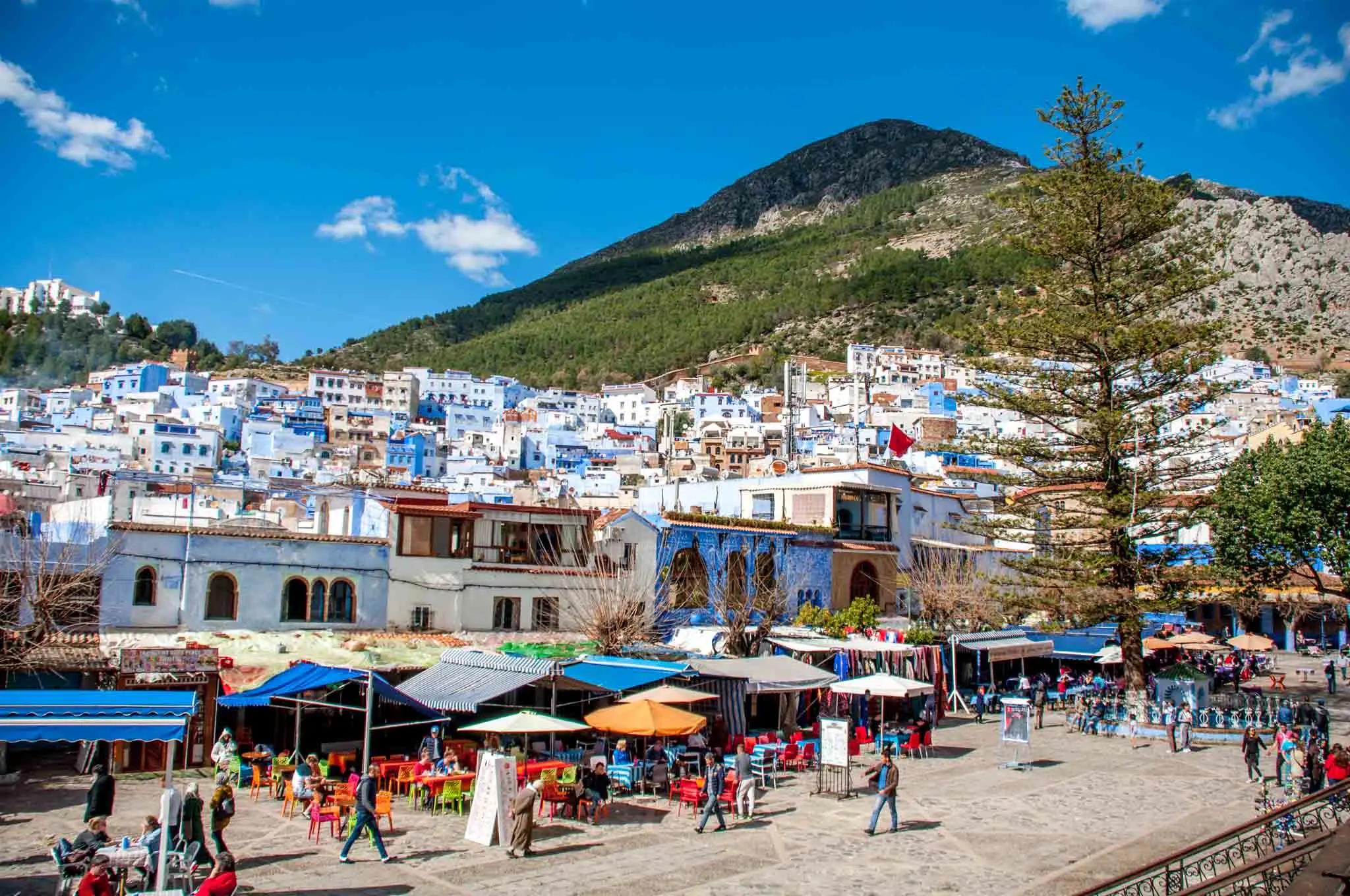
The stories vary about why Chefchaouen is blue, but it’s 100% true that most of this lovely town is painted in hues of royal, aqua, or baby blue throughout the year. It’s completely mesmerizing (maybe partially because our favorite color is blue). The best part of visiting Chefchaouen is getting lost in the medina and traversing the lanes up and down the hills while watching the colors change in front of you.
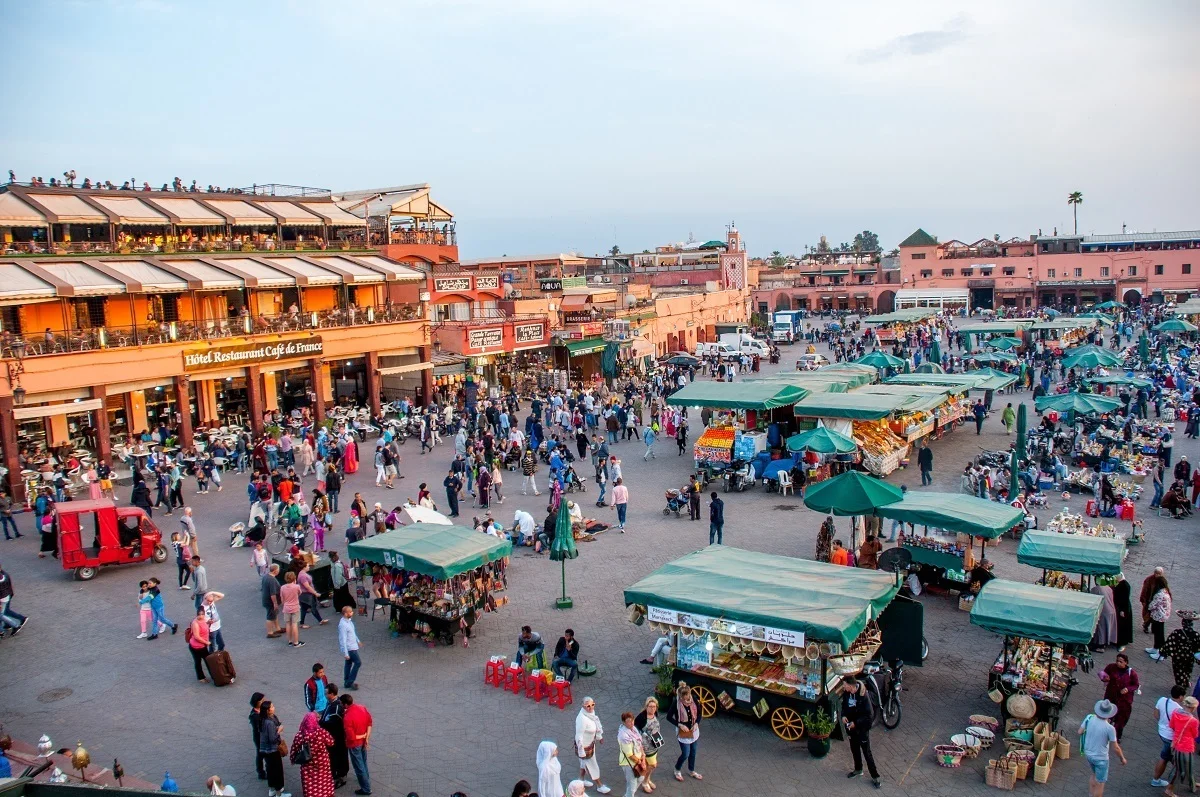
Unwanted attention is basically a sure thing
I hope it’s obvious by now just how lovely Morocco is. Most people also want to know if it’s safe to travel to Morocco and if women traveling in Morocco should be comfortable. The answer to both those questions is “yes,” but there are some caveats. A big one is that female travelers are likely to receive a lot of unwanted attention.
When we visited Egypt several years ago, my sister and I got yelled at in markets and followed through squares, and someone even offered to buy her. After that, I felt prepared for anything Morocco might bring.
While I certainly got catcalled in Fez and Marrakech, it wasn’t significantly worse than what I’ve experienced in any big city in the US. Being catcalled in Morocco is inevitable regardless of what you’re wearing or who you’re with, so do your best keep your head down, ignore it, and keep walking. And, above all, don’t let it ruin your trip.
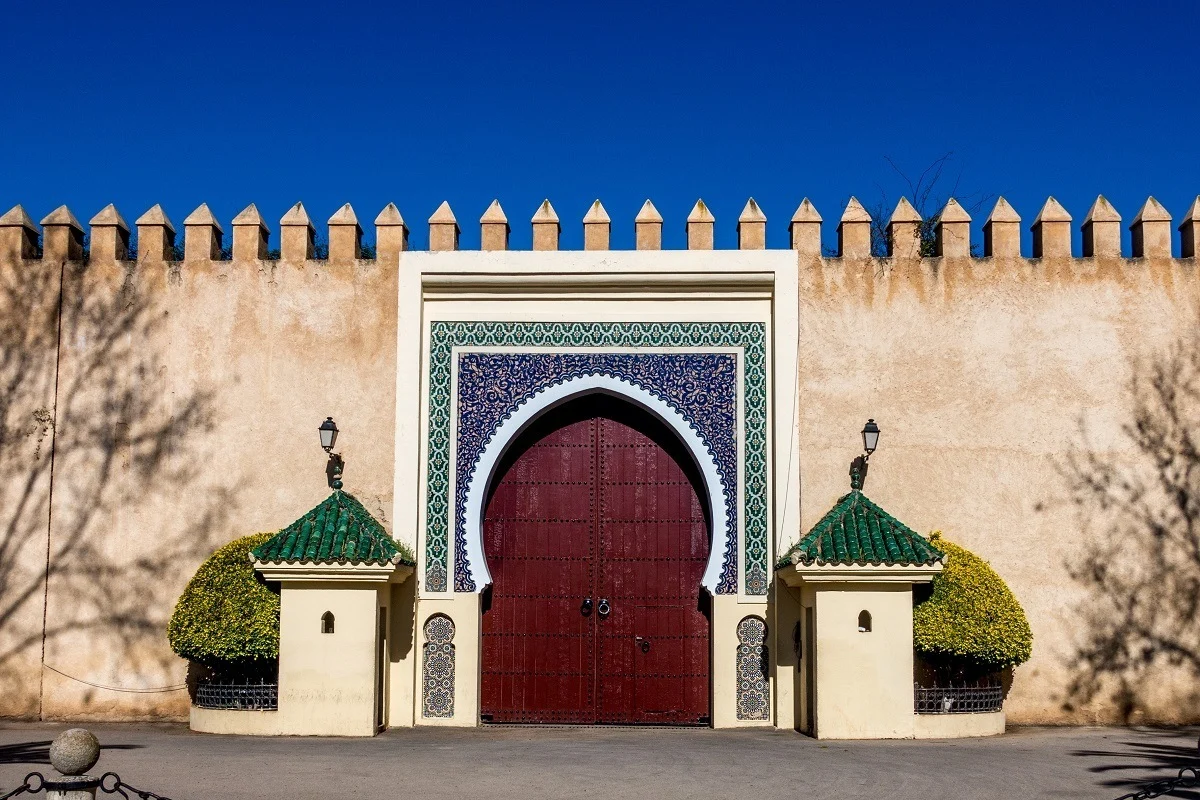
Dressing modestly is a good idea
Everyone has a different idea of what “appropriate dress” is. When we travel, we try to respect local customs, so we dress and behave accordingly.
The truth is, you can wear whatever you want in Morocco. Wearing tank tops and short shorts isn’t a crime, but it’s likely to draw a lot of attention you definitely don’t want, and you’ll probably feel more uncomfortable in the end. Your best bet for feeling comfortable is dressing modestly, covering shoulders, legs, and cleavage.
The juice is unbelievable
Fruit is unbelievably cheap throughout Morocco. Don’t hesitate to indulge in the fruit juice stands whenever they’re available. We found them most often in Chefchaouen and Jemaa el-Fnaa in Marrakech, but I’m sure they can be found elsewhere.
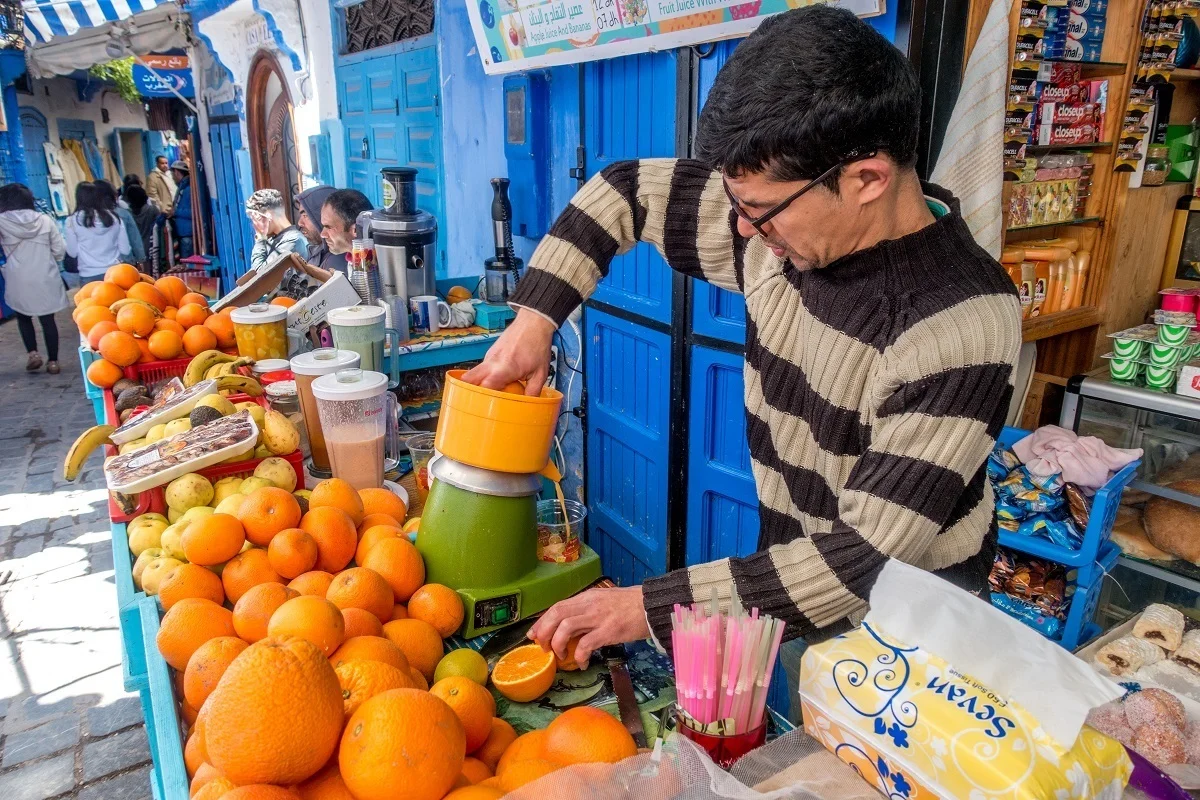
For less than $1USD, stands will juice just about any fruit you can think of right in front of you. And, my goodness, is it delicious. It’s even cheaper if you stand there to drink it than if you take away.
For the sake of comparison, we paid $1 in Chefchaouen for the same portion of fresh-squeezed orange juice that we paid nearly $5 for in southern Spain. It was so good that we had two glasses in one day. Heaven!
Traditional Moroccan food is fabulous
Food in Morocco is plentiful and super affordable. In many places, you can get delicious main dishes for about $8USD, and the portions are large enough to feed a small army. Once you add in bread and a starter to share, you’ll be looking to take the long way back to your riad to walk off a little of dinner.
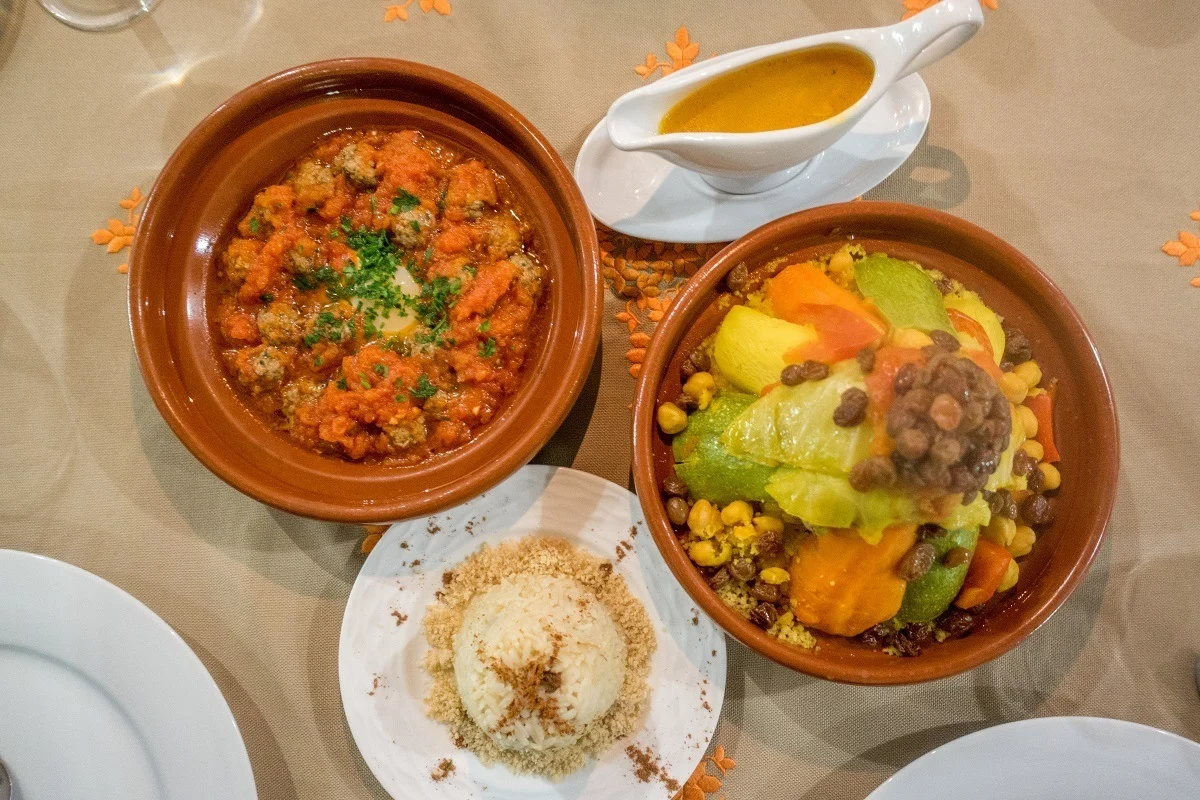
Dishes vary across restaurants and cities, but there are four dishes you’ll find in most places—tagine, kefta, pastilla, and couscous.
Tagine is both the clay pot cooking vessel and the name of the dish that includes a variety of different vegetables and usually lamb, chicken, or beef. Kefta is seasoned ground beef meatballs (sometimes served on skewers). One of the best meals we had in Morocco was kefta at a roadside stop. SO good.
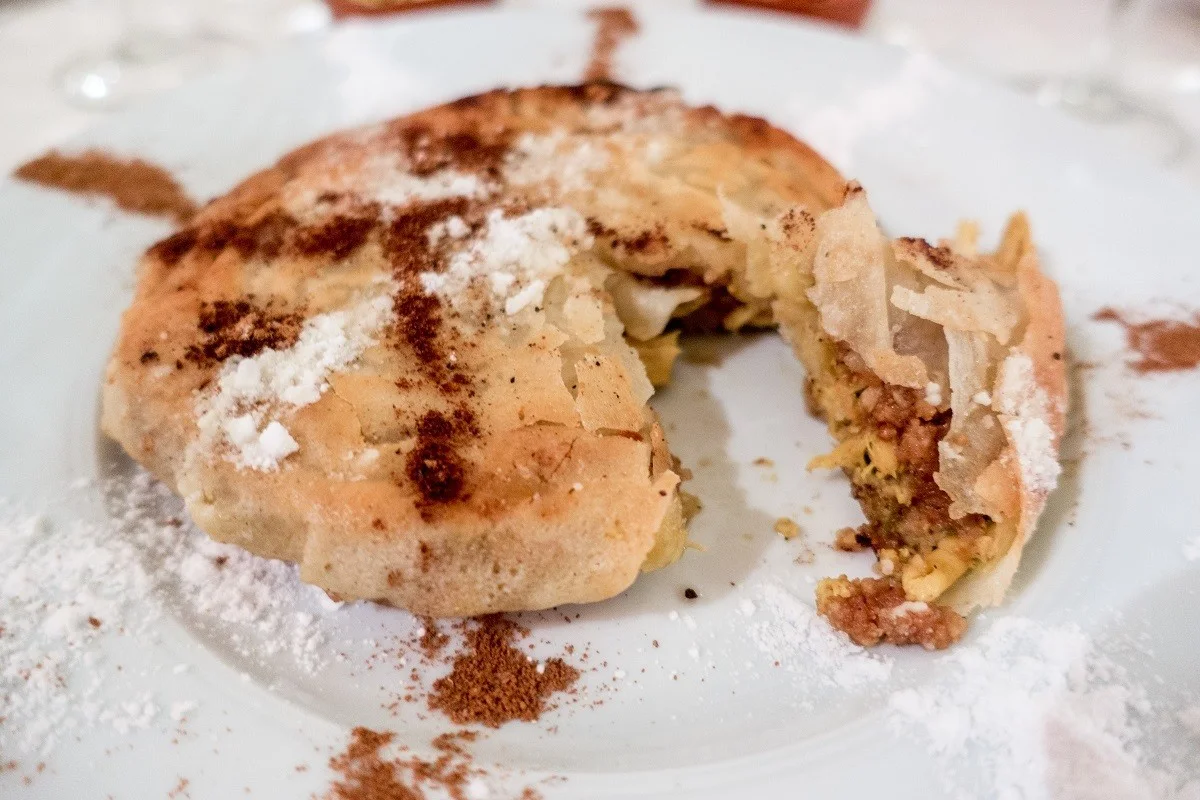
Pastilla is a Moroccan pie with a flaky crust that can be filled with fish, chicken, or squab (occasionally awkwardly translated as “dove”). It also has a layer of ground almonds, cinnamon, and sugar. Couscous—cooked semolina with vegetables and other accompaniments—is a regular on Moroccan tables, and particularly on Fridays to celebrate the holy day.
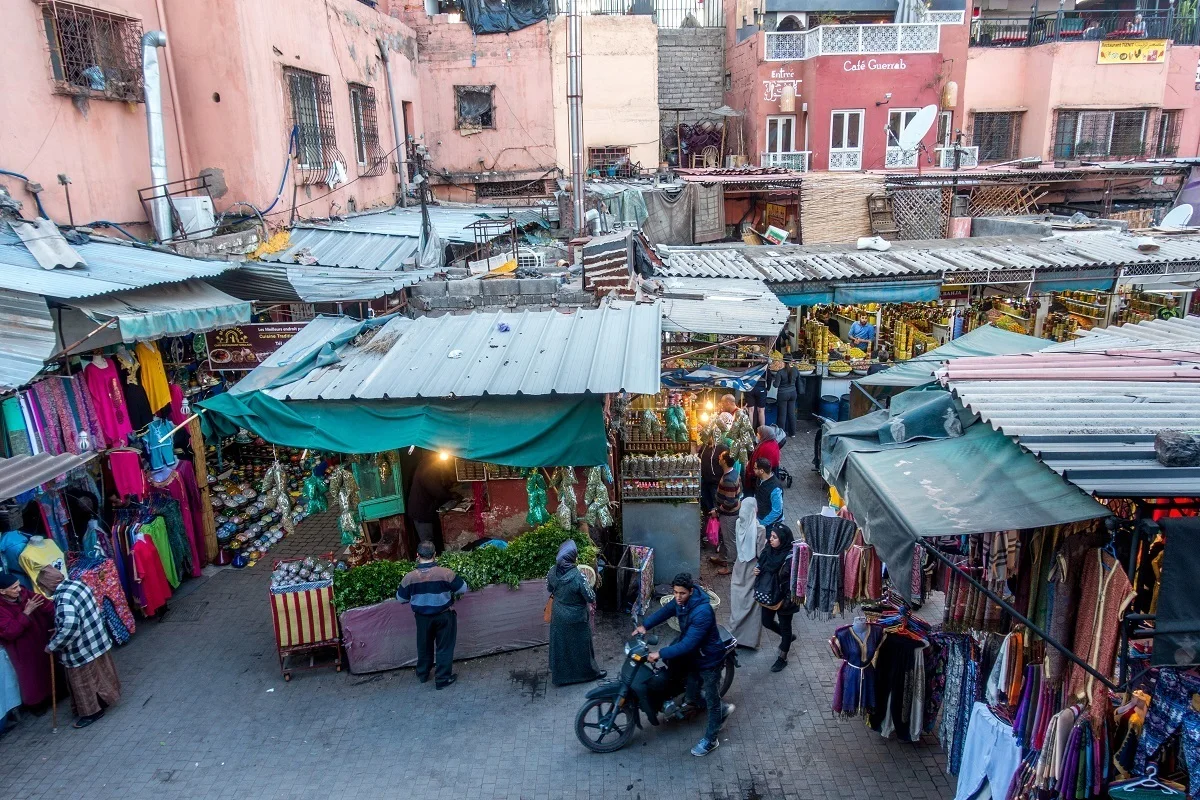
You’re going to get lost
The bigger medinas in Morocco have hundreds of shops, workshops, and food stands not to mention thousands of residents and visitors going about their daily lives. To say there is a lot of activity is an understatement.
At the same time, the alleys and streets twist and turn leading to squares, dead ends, and whole new sections of the medina you didn’t know existed. Even smaller medinas have an organization that is likely to confuse most visitors. Did I mention that many of the alleys are also quite dark?
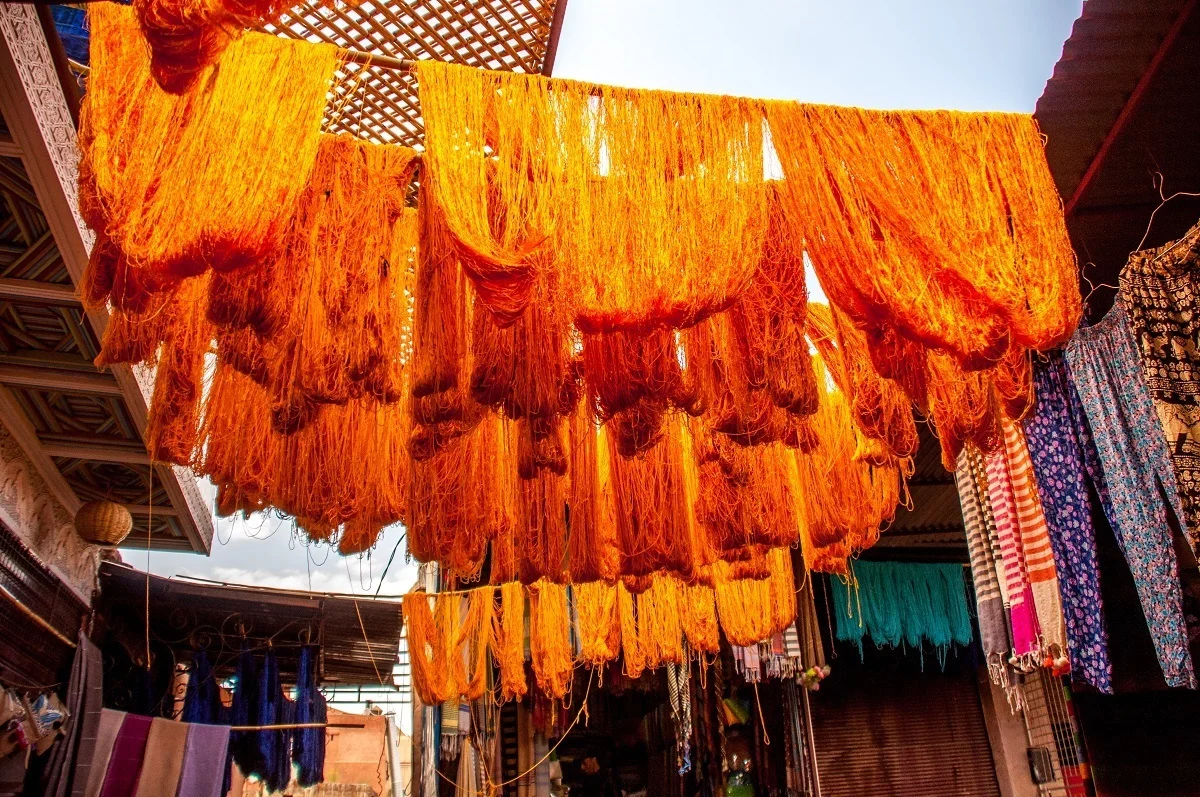
The reality of visiting medinas and souks in Morocco is that you will probably get lost. It’s basically proof that you’ve had a real Morocco experience. It can be quite fun, but it can also be a little bit scary if you’re out at night. One of our top Morocco travel tips is to always carry a card with your hotel or riad’s address in case you need help finding your way back. Assume that a tip will be expected.
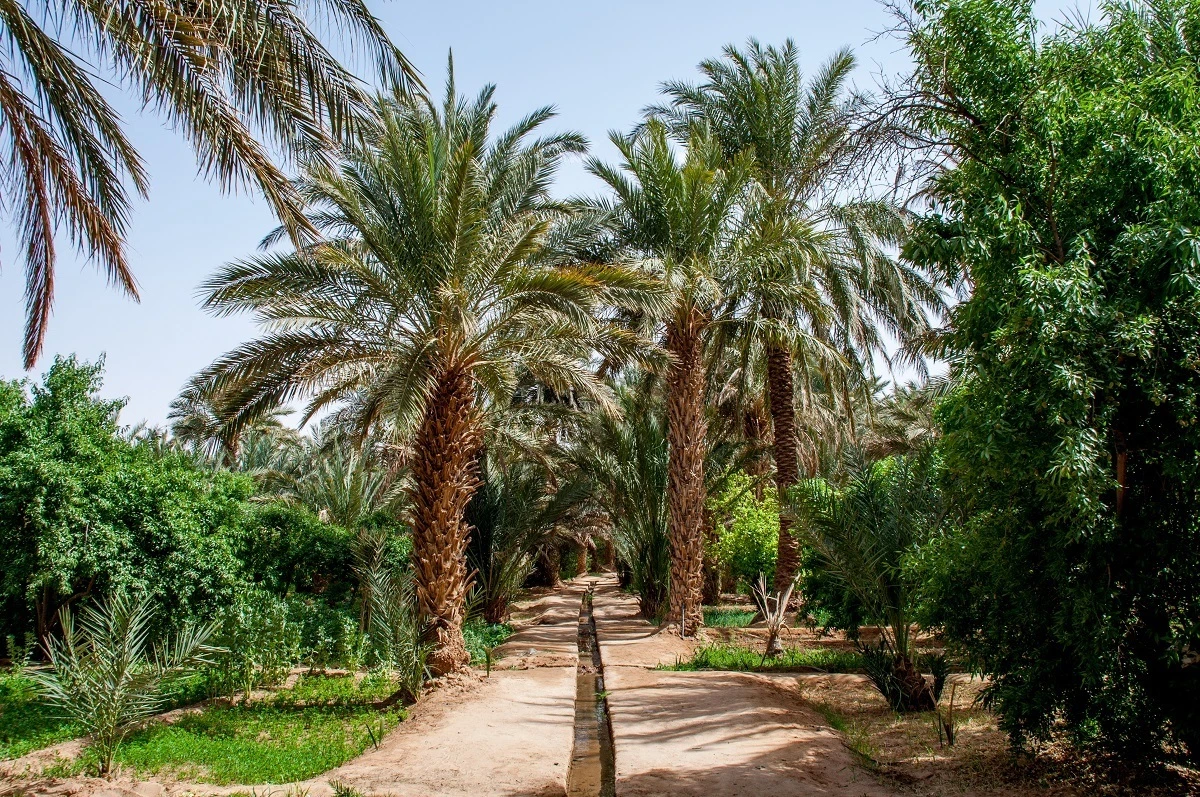
Having cellular or wifi access is really helpful
Having cellular or wifi access requires planning for people traveling to Morocco from abroad, but it’s a helpful thing to have. While many people like to disconnect on vacation, a smartphone is a valuable tool in a country where you may not always speak the language, or where you need directions or other information.
Cell coverage is generally good other than in the most remote areas, and 4G is available in most cities and many towns. But how do you access it?
The two best solutions for online access when you visit Morocco are to travel with an unlocked phone or to rent a wifi hotspot. If your phone is unlocked, buying a local SIM card can keep you connected very cheaply. If that’s not an option for you, consider a wifi hotspot. A hotspot will keep you connected when out and about and will come in handy if your riad or hotel has weak wifi, which we experienced several times. We wrote in more depth about our experience using a wifi hotspot in Morocco here.
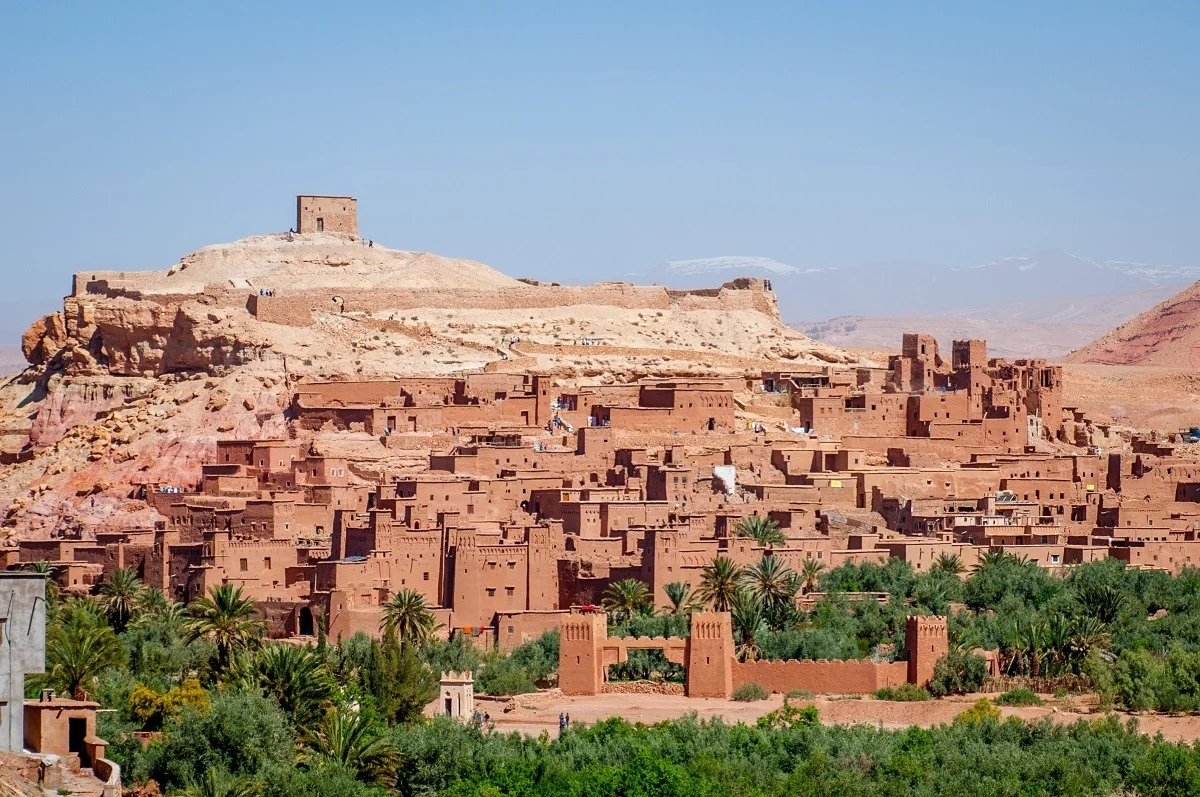
You won’t find toilet paper everywhere
It’s easy to take for granted that restrooms will have toilet paper, but that’s simply not the case everywhere in the world. The best plan is to have a stash of your own with you at all times.
Americans are generally not used to paying to use the toilet—much less not having toilet paper—although that’s common in many places in the world. In Morocco, you often get lucky and find someone manning the restrooms. Usually a few dirham will get you a relatively clean restroom and a few pieces of paper. But sometimes you encounter a place without any. That’s when you’ll be glad you’re prepared.
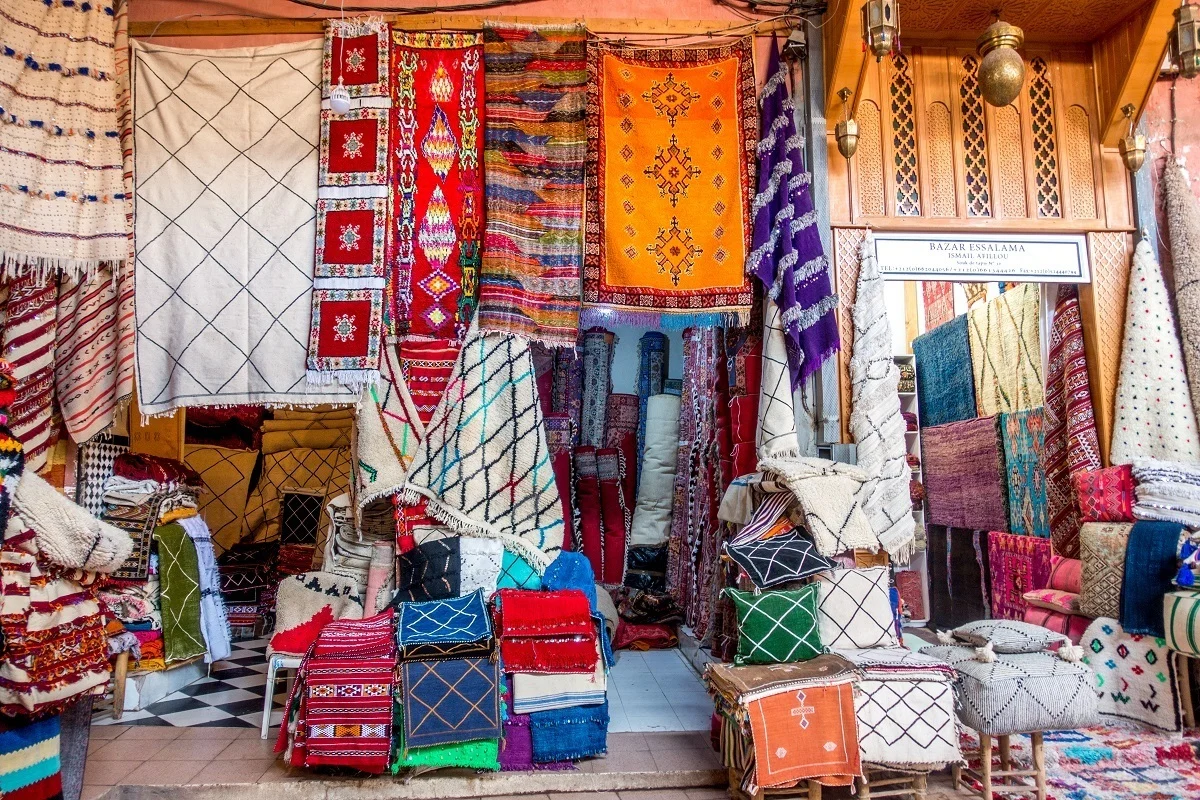
Bargaining is part of the culture
Haggling is practically a national sport in Morocco, so be ready if you’re planning to head home loaded down with souvenirs. It can be a little uncomfortable, but if you look at it as a game instead, haggling can actually be fun.
Here’s the thing: prices at souks in Morocco are dramatically marked up. The shopkeepers expect haggling. And since no one wants to feel like they paid four times too much for an item, it’s a good idea to get comfortable with the fact that there’s going to be a good deal of back-and-forth before you walk away with your purchase.
Most Morocco travel guides advise starting your bargaining at 1/3 of the price you’re quoted, So, if you’re quoted 1000 dirham, offer 300 in return. Most of the time, you should reach an agreement at about 50-60% of the original price. Never seem too interested, and be prepared to walk away.
There are goats! In trees!
It’s hard not to be a sucker for goats. I mean, they’re adorable. And there’s a place in western Morocco between Marrakech and Essouira where you’re likely to see them in trees.
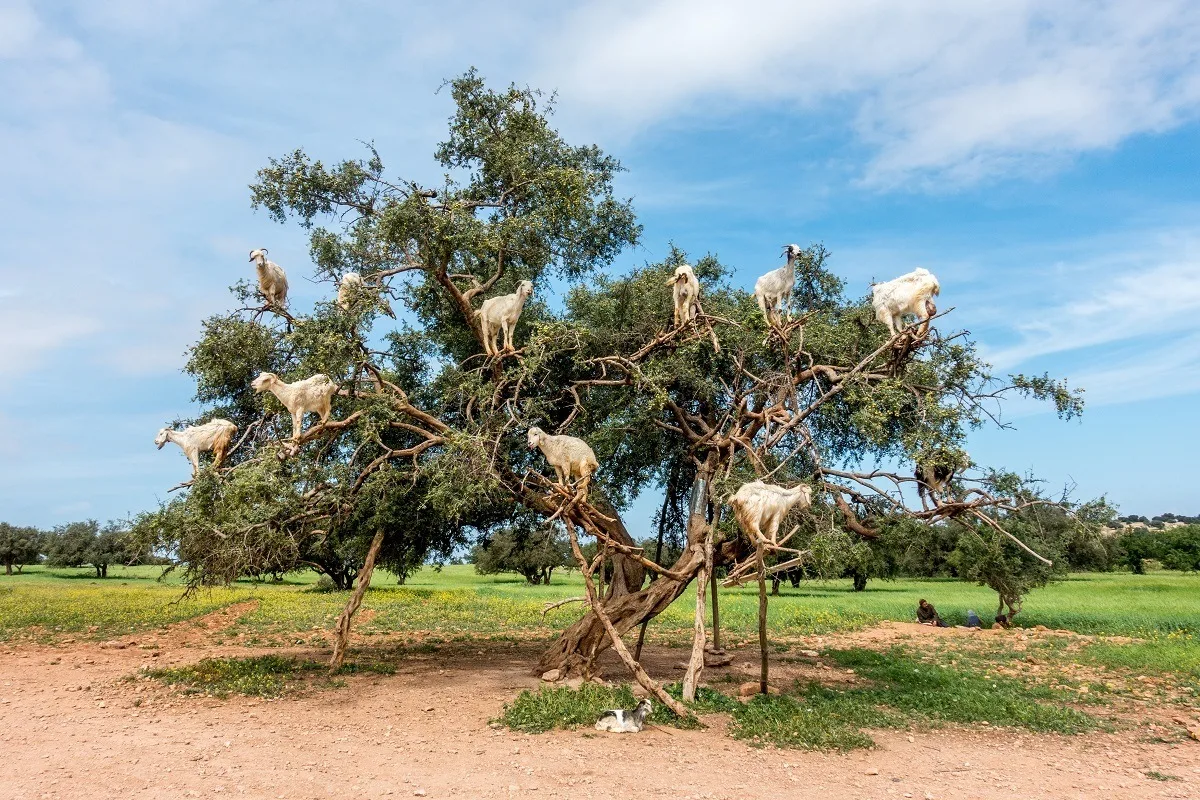
In the past, farmers coaxed the goats into the argan trees to gnaw on the tough seeds that hang from the branches. The goats ate and— shall we say, “processed”—the seeds, making it easier for farmers to extract the valuable contents inside the seeds.

Nowadays, there’s machinery to process the argan in an easier way, so the goats-in-trees thing is done for tourists who are suckers for these cuties. Although it’s not as authentic as it once was, there’s no question that it makes for an amazing photo. And, if you’re lucky, you might just get to hold a kid.
There are awesome Roman ruins
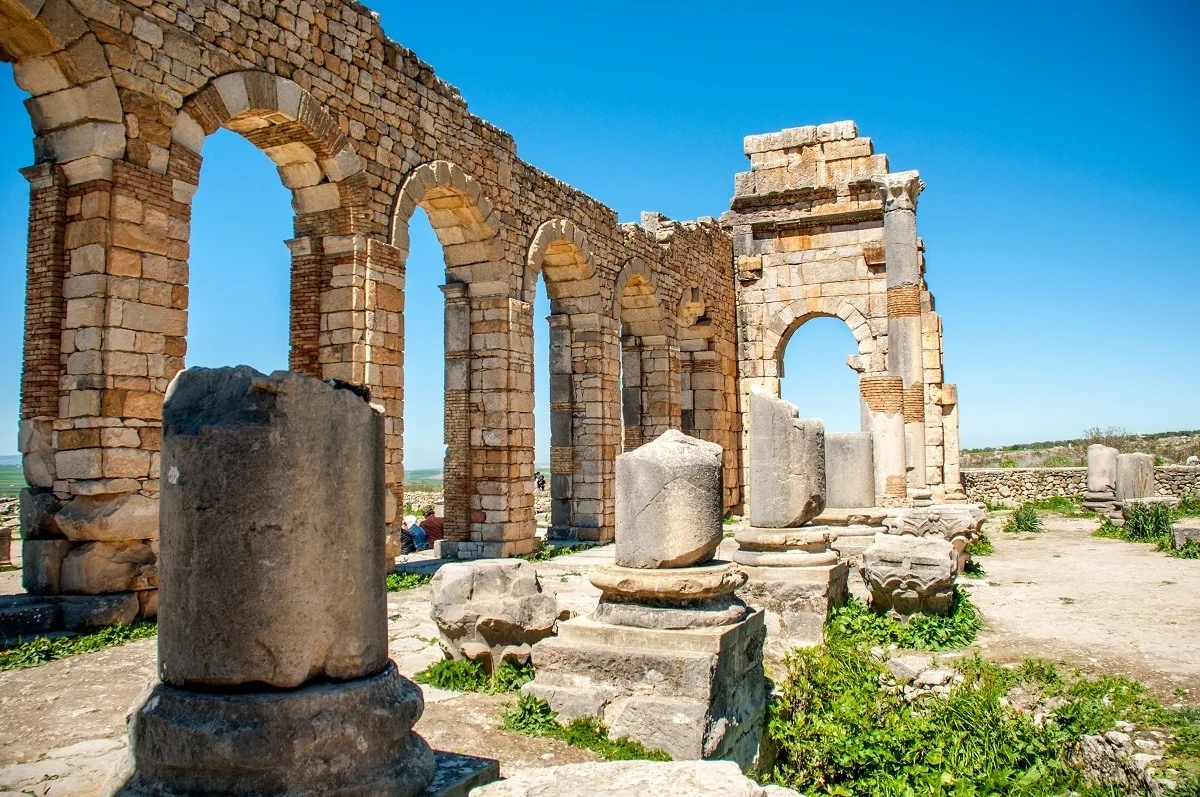
The influence of ancient Rome stretched far and wide, all the way to Morocco and beyond. Few visitors to Morocco make it to the country’s Roman ruins because of their locations, but these 2000-year-old sites are worth a detour. On this trip, we made it to two of the three sites–Chellah in Rabat and Volubilis, about two hours away.
Volubilis, located at the foot of the Atlas Mountains, was at the western edge of the Roman Empire. The footprints of its buildings, its triumphant arch, and the intricate mosaics tell the tales of its wealth even 2000 years later. All this thanks to money made from olive oil.
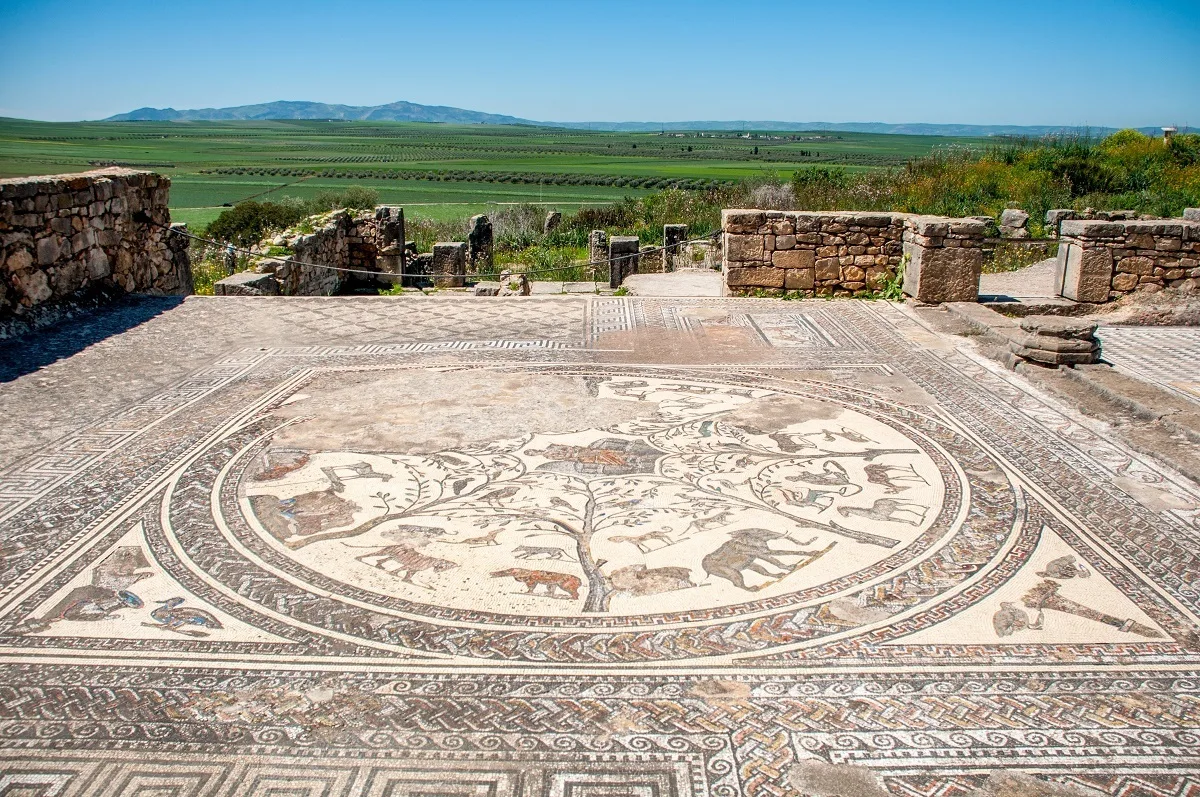
This UNESCO World Heritage Site is dominated by the remains of buildings around the forum, with arches of the basilica in front of pillars of the Temple of Jupiter. Nearby, the Arch of Caracalla is visually striking in its size and completeness. The city that was once home to 20,000 residents now seems to be in the middle of nowhere, but its large number of beautifully-restored mosaics testifies to its importance.
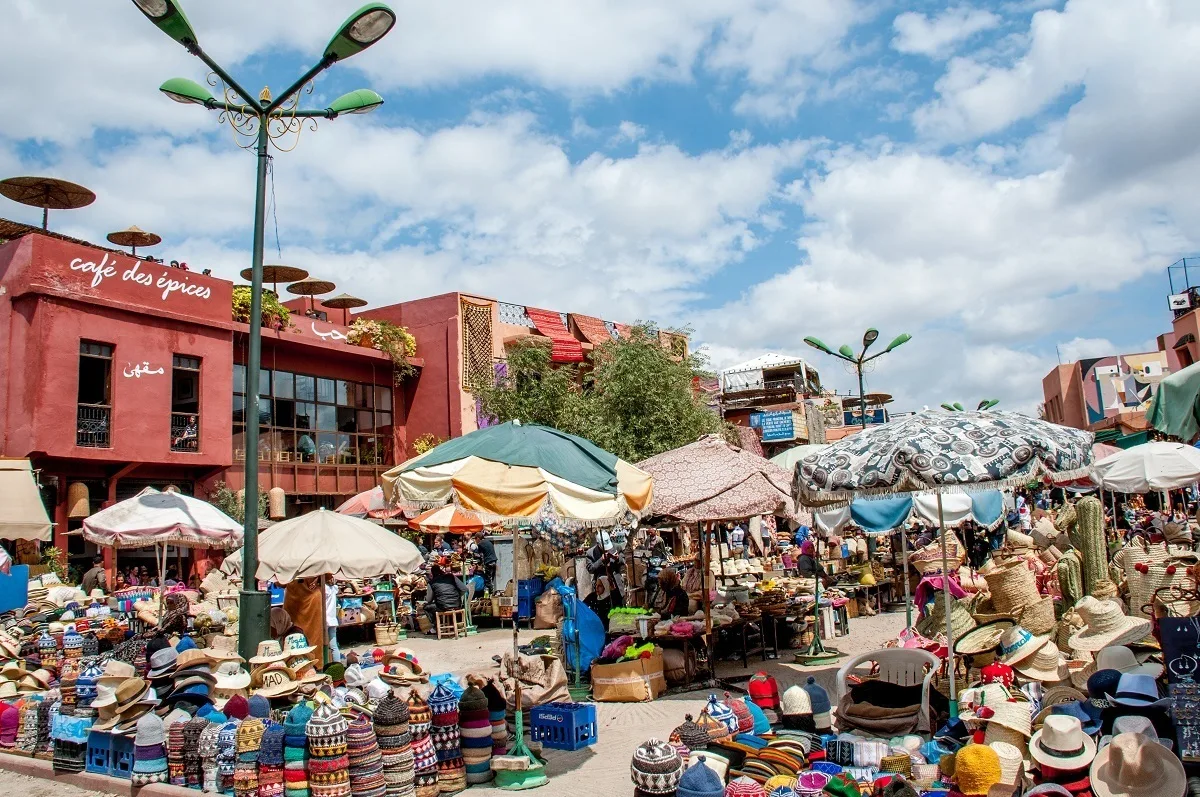
Scammers abound
Marrakech is known as “scam city.” In the tourist areas, there are lots of people just waiting to hassle you a little bit in hopes of separating you from your money.
There are lots of “nice guys” trying to be your friend and offering to assist you in some unwanted way. They’ll ask what language you speak or where you’re from, maybe compliment you, and then offer you a tour, to show you where to buy the best rugs, or something else you’re not in the market for. Then, there are the people who come up and immediately put an animal on your back or in your hands.
This practice not limited to men, though. When we looked a bit confused walking back to our riad at night, two different boys gave us wrong directions we didn’t ask for. Once, a woman came up to me and grabbed my hand to start doing henna, unprompted. I don’t respond well to being grabbed by strangers.
Our best Morocco travel safety tip: don’t let your desire to be polite guide you into interacting with any of these kinds of scams. Use common sense and a definitive “no” (“la” in Arabic) and keep on walking.
Tanneries look—but do not smell—beautiful
Photos of the tanneries were one of the first things that intrigued me about visiting Morocco. The circles filled with dozens of colors and the people wandering among them make for an amazing mosaic when seen from above. Not to mention that the dyers are doing something most people have never seen before in a manner that hasn’t changed much since medieval times.
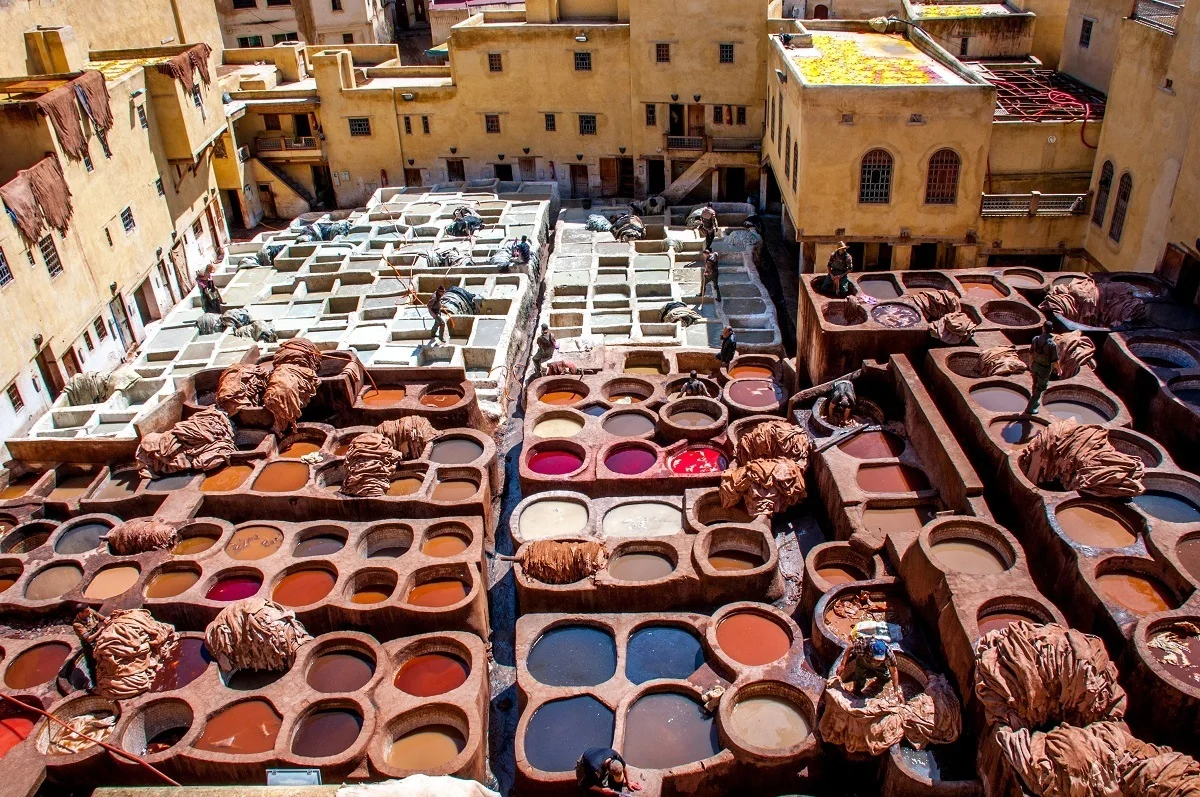
The thing that may not initially be obvious about the tanneries, though, it that some of those vats hold urine, water mixed with pigeon poo, and other unsavory solutions in order to prepare the hides. In the sweltering cities of Fez and Marrakech where you’ll find the tanneries, the vats and hides get hot. And they stink.
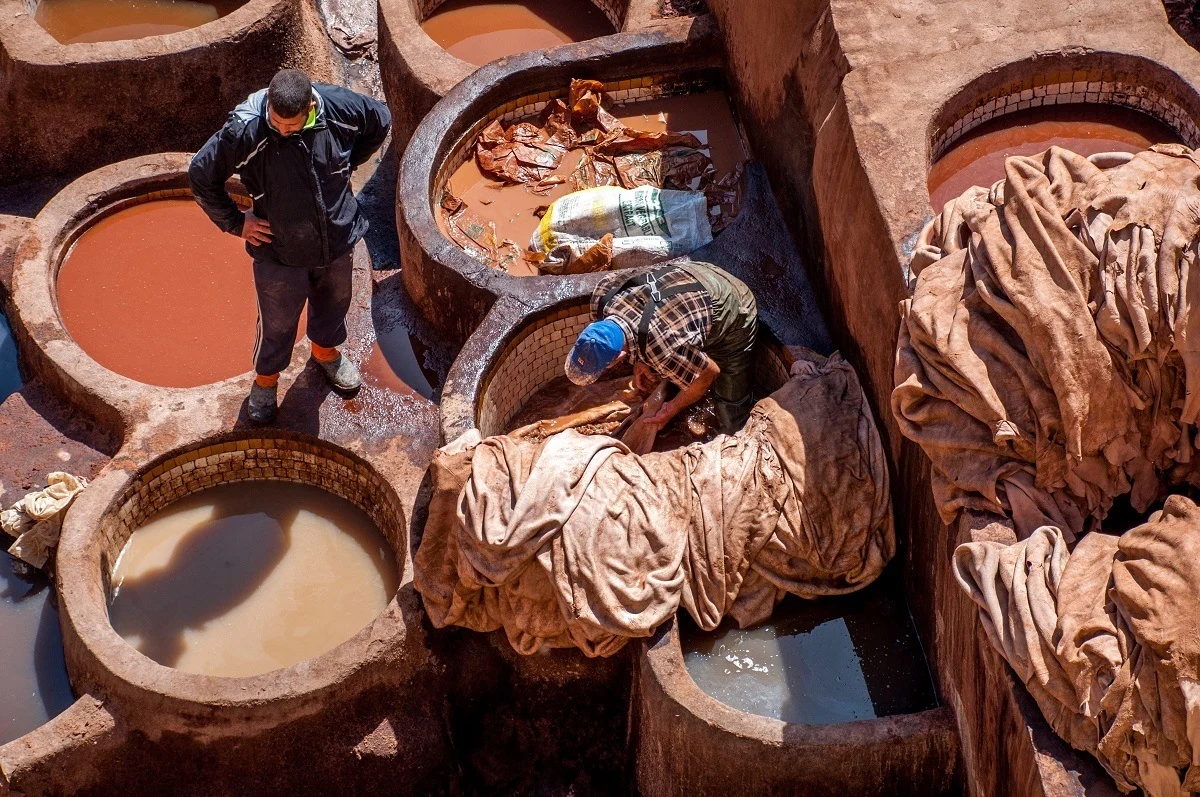
The tannery viewing experience will come with a sprig of mint to dull the tannery scent. We even saw some people who had shoved the mint up their noses. Our best Morocco travel tip: visit Morocco outside of the summer, if you can. During our visit in April, the scent was totally bearable.
It’s not always hot in Morocco
Lots of areas in Morocco get very warm during the day. In the spring and summer, temperatures in Marrakech range from 80-100 degrees. It’s even warmer in the desert, though it cools down substantially at night. Just three hours from Marrakech on the coast, Essouira is often 30 degrees cooler and windy. Before your visit, check the weather, and always pack a jacket just in case.
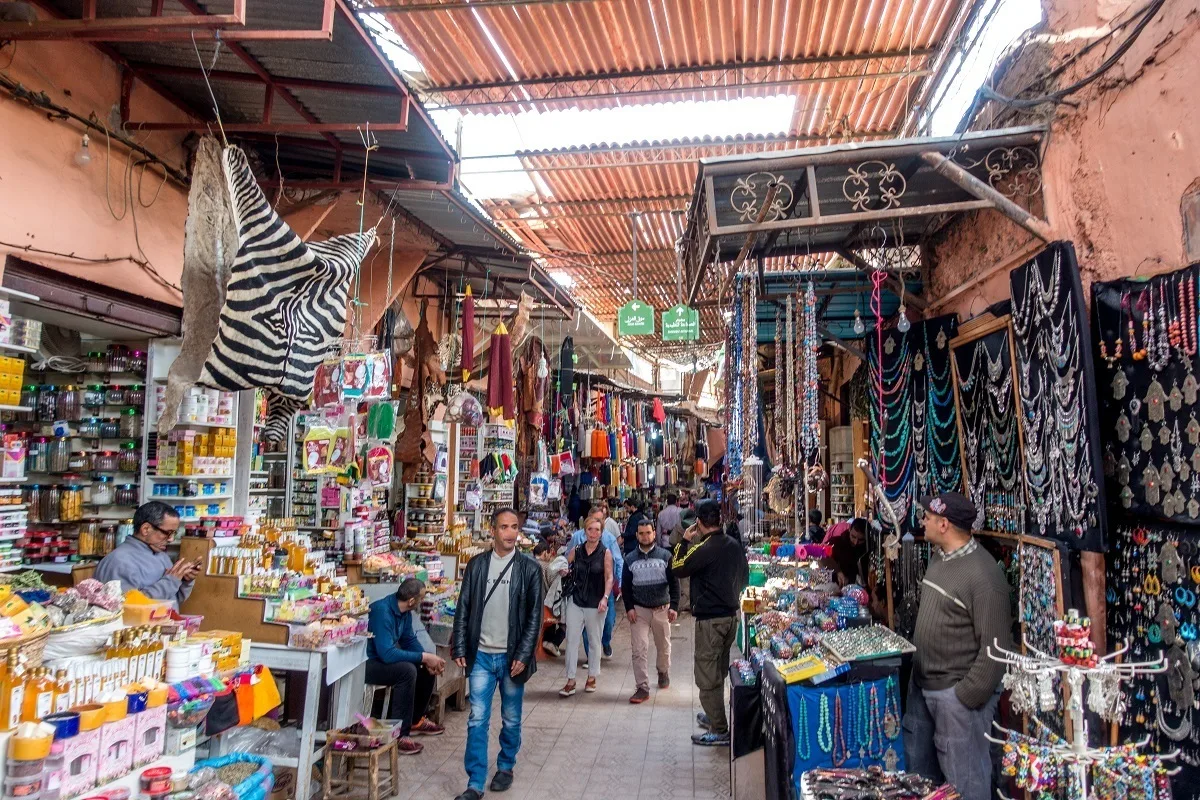
Having cash is necessary
One of the first things you do on your trip to Morocco should be to get cash. Morocco has a closed currency, which means it’s generally not available outside the country, but you’ll need plenty of it. Your first opportunity will likely be in the airport when you arrive.
Few places other than more expensive restaurants and supermarkets take credit or debit cards. You’ll need cash for most meals, buying most items in the souk (outside of a high-cost rug or leather good), taxis, and tipping. Finding an ATM in larger cities is relatively easy, but planning ahead is always a good idea.
Hectic Marrakech has a garden oasis
In the middle of Marrakech is a sprawling garden complex that feels a world away from the activity of the city. Jardin Majorelle is home to hundreds of varieties of plants plus fountains, ponds, and other peaceful additions.
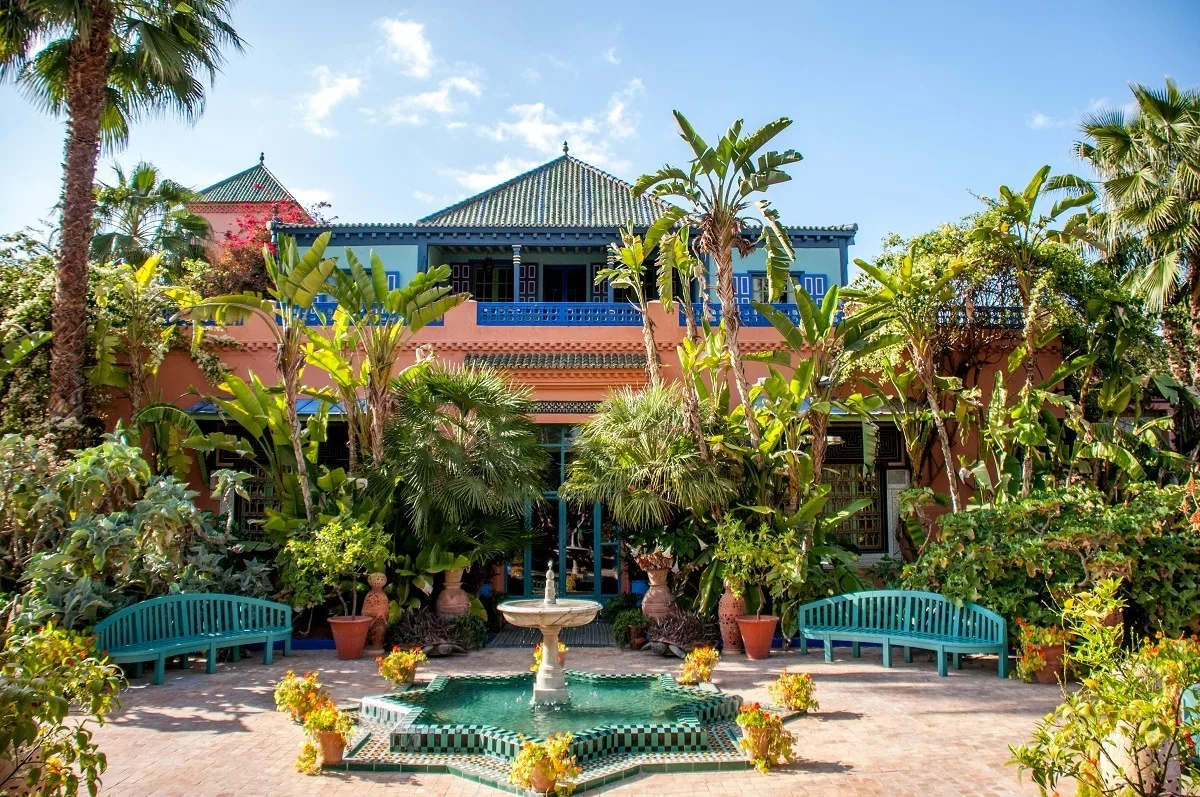
The brilliant garden was built by French Orientalist artist Jacques Majorelle over 40 years beginning in 1923 and was revived in the 1980s after being purchased by fashion designer Yves Saint Laurent and Pierre Bergé. Jardin Majorelle is now the top attraction in all of Morocco.
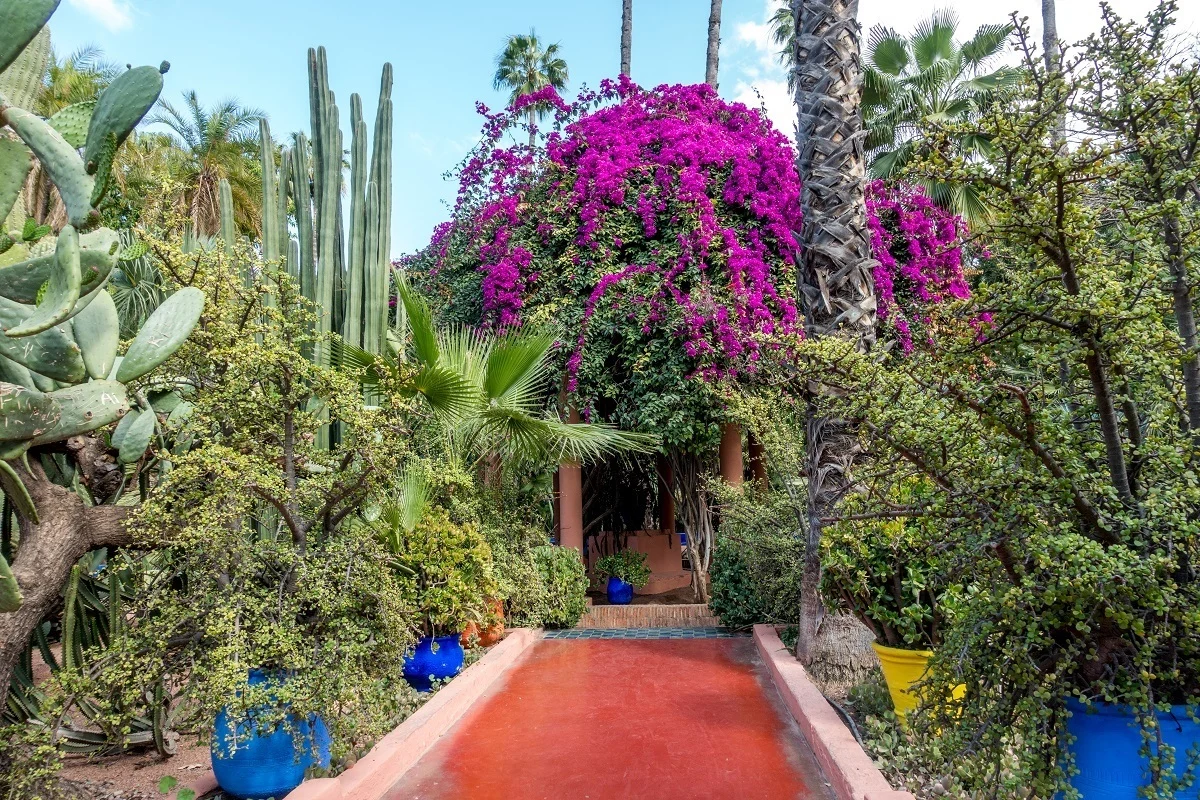
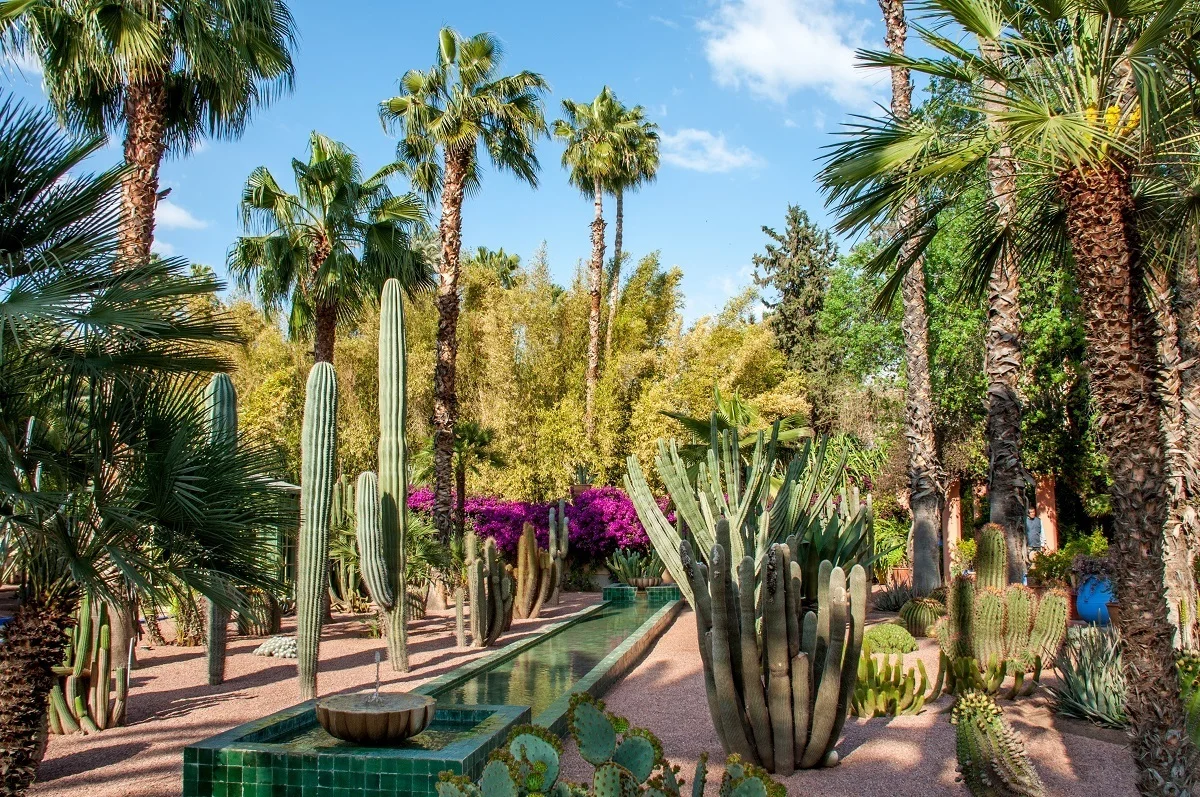
Visitors can walk among plants from five continents, lose themselves in the splashing fountains, and gaze at the art deco bright blue (known as Marjorelle blue) buildings. During our visit, Saint Laurent’s private garden was also open to visitors, which is a rare occurrence.
It is worth noting that the line to get into Jardin Majorelle can be long. Plan ahead and leave plenty of time for your visit. It’s worth it.
Laura Longwell is an award-winning travel blogger and photographer. Since founding Travel Addicts in 2008, she has written hundreds of articles that help over 3 million people a year get the most out of their travel. In that time, she has visited nearly 60 countries on 5 continents, often returning to favorite destinations over and over again. She has a deep love of history, uncovering unexpected attractions, and trying all the good food a place has to offer.
In addition to Travel Addicts, Laura runs a site about her hometown of Philadelphia—Guide to Philly—which chronicles unique things to do and places to see around southeastern Pennsylvania. Her travel tips and advice appear across the web.

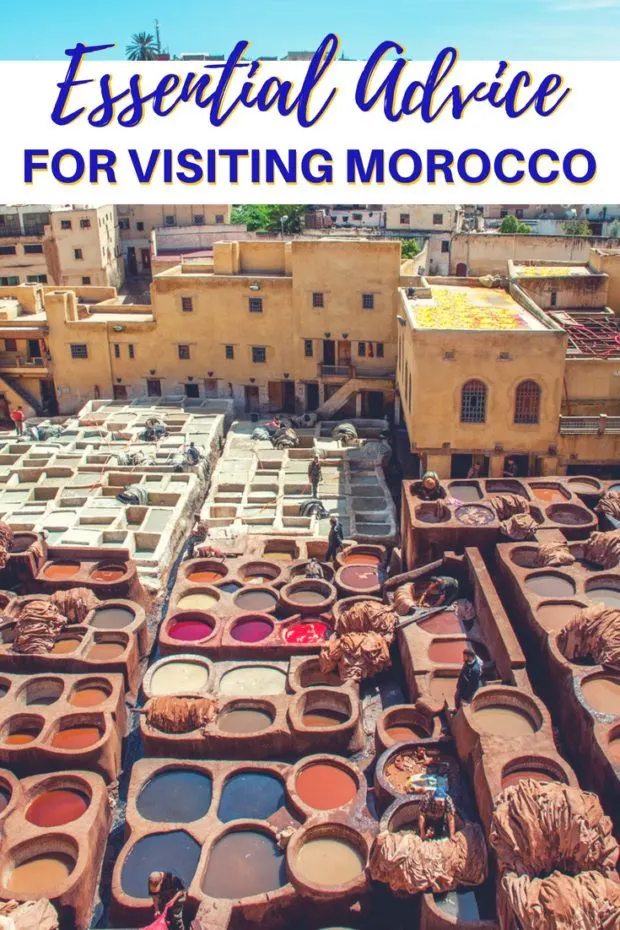
David
Wednesday 2nd of March 2022
We are going to Morrocco very soon and have never been there. Unfortunately we have limited time.....only 2-1/2 days at the end of a European trip. Right now, we are staying in Casablanca for the 2-1/2 days, but could cut one of the days out for a day trip to Marrakech. What would you advise?
Laura Longwell
Wednesday 2nd of March 2022
I think you would be very disappointed to spend that amount of time in Casablanca. It's the business center and has minimal attractions compared to other cities. I would definitely recommend going to Marrakesh.
Isabel
Monday 5th of July 2021
Thank you for your detailed information and recommendations. We are going to Morocco in a few days and I appreciate all of your advice.
Laura Longwell
Monday 5th of July 2021
That's great! I hope you have a fantastic time.
Aliny
Friday 16th of August 2019
Came across your site! Thank you for the great insight! Did you arrange your private transportation offshore or once you arrived in Morocco? Did you use any specific service.
flor
Thursday 30th of May 2019
the goats on the trees are really unbelievable!!!!
Emily Lowe
Wednesday 19th of September 2018
Great list! I visited Morocco two years ago and it was quite an experience. It's so different to anywhere else I have been. You're very right that visitors to Marrakesh should be wary of scammers, we were a little ignorant of this when we visited and a man tried to charge us for giving us directions in the souks...
My favourite place in Morroco though was Imlil, a Berber village, in the Atlas Mountains. The people were so sweet and we even managed to hike Toubkal! I recommend it if you haven't been.